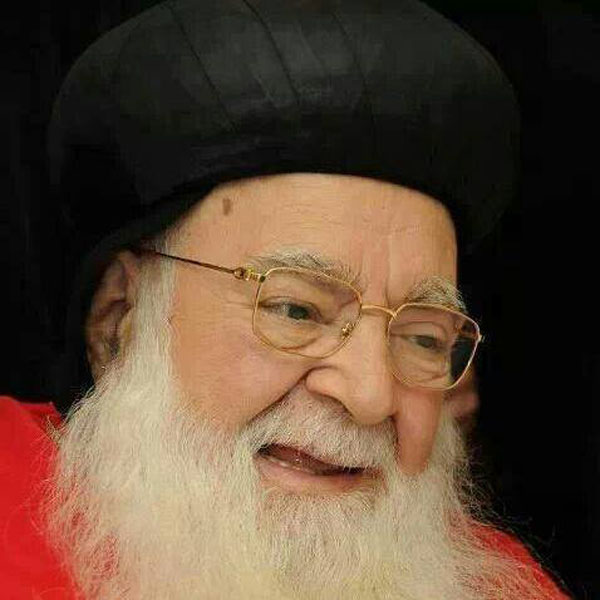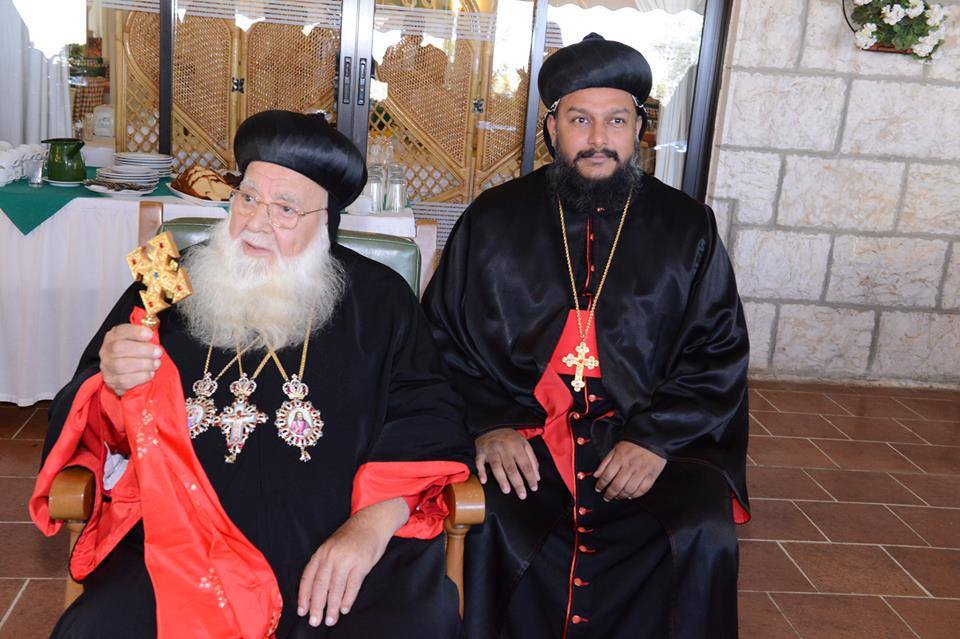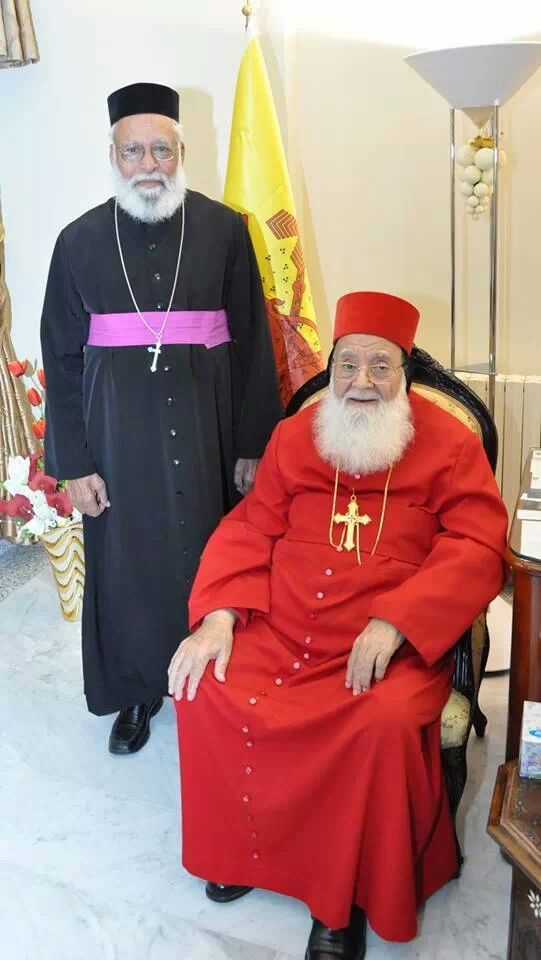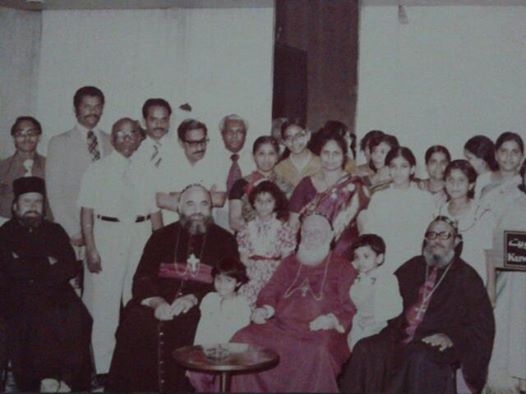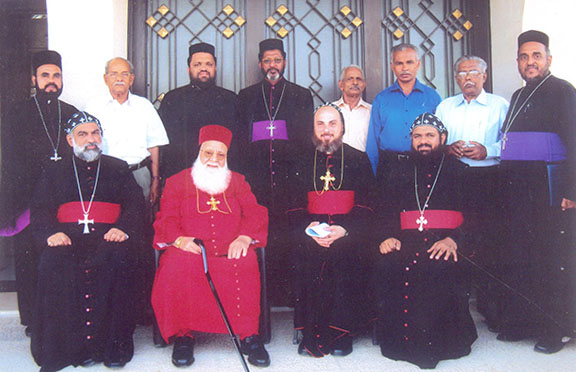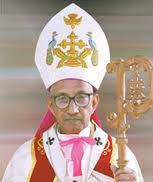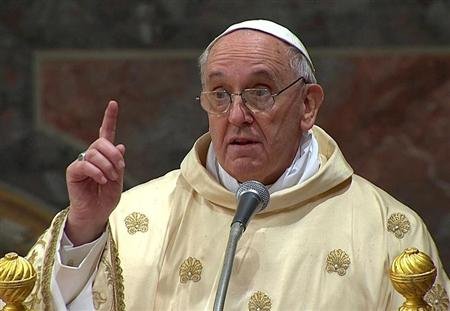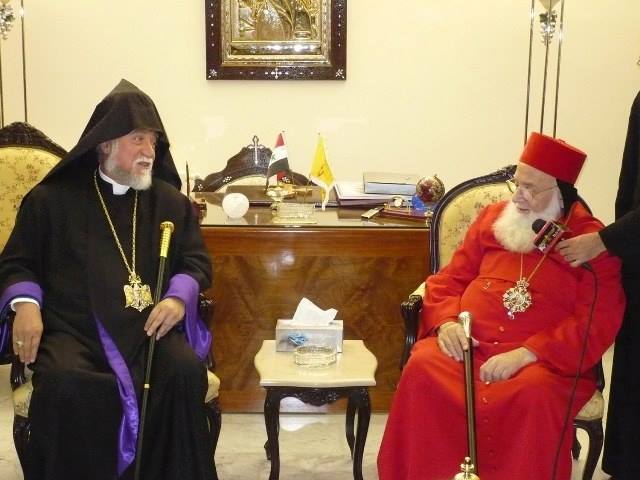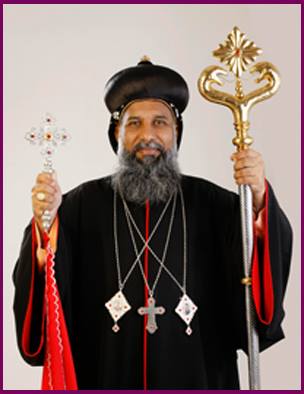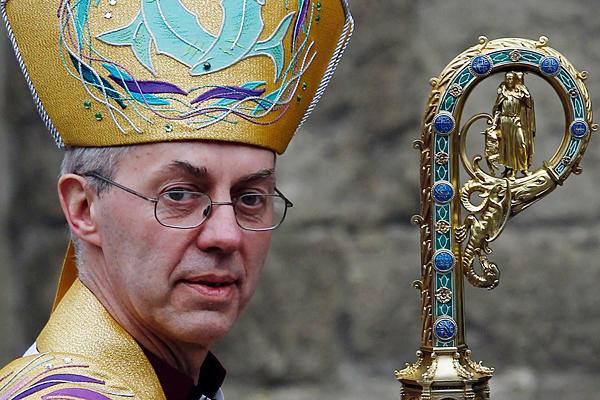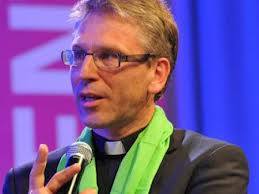
|
||
|
Malankara World Journal
LL Ignatius Zakka I Iwas, Patriarch of Antioch
and All The East, Special Supplement
Volume 4 No. 206 April 1, 2014
If the Journal is not displayed properly, please click on the link below (or copy and paste) to read from web
http://www.MalankaraWorld.com/Newsletter/MWJ_206.htm The Photo Supplement may be perused here: http://www.MalankaraWorld.com/Newsletter/MWJ_206photo.htm Archives: http://www.MalankaraWorld.com/Newsletter/Default.htm |
||
|
||
|
TABLE OF CONTENTS
|
||
|
If you are not receiving your own copy of
Malankara World by email, please add your name to our subscription list. It
is free. click here.
|
||
|
1. Foreword by Dr. Jacob Mathew, Editor-in-Chief, Malankara World 2. Unforgettable Memories - A Shepherd Who Captured My Heart by HB Baselios Thomas I, Catholicose 3. 'Our Patriarch is The Best' - Journey Down The Memory Lane by HE Yeldo Mor Theethose 4. An Interview with Archbishop HE Yeldo Mor Titus (Malayalam) 5. A Tribute to Our Departed Holy Father by Rev. Fr. Paul Thotakat 6. A Saint in Damascus by Very Rev. Abraham O. Kadavil Cor Episcopa 7. Patriarch Ignatius Zakka I Iwas: The Equinox On Which The Church Rode Three Decades By Rev. Fr. Jerry Kurian Kodiattu, Malankara World 8. Footprints on My Heart by Janice Mathew, Malankara World 9. Pontiff to Legend By Rev. Fr. Jose Daniel Paitel, Malankara World 10. A Patriarchate Blessed by The Holy Spirit by V. Rev. Fr. Dr. Kuriakose Corepiscopa Moolayil, Malankara World 11. In Memory of LL Ignatius Zakka I Iwas A Poem by Sunitha Jijo Flowerhill, Malankara World 12. A Saint from Mosul by George Mathew 13. The Ecumenical Vision of H.H. Ignatius Zakka I, LL Patriarch of Antioch by HG Naheero Dr. Thomas Mor Themotheos 14. A Historical Agreement After More Than Fifteen Centuries by Archbishop Mar Powathil APOSTOLIC VISITS THAT MADE HISTORY 15. The Apostolic Visit of His Holiness Ignatius Zakka I by HG Dr. Kuriakose Theophilose Metropolitan 16. A Historic Apostolic Visit To India 17. Address of H. H. Patriarch Ignatius Zakka I Iwas at The Second Mulanthuruthy Synod SELECTED TRIBUTES FROM WORLD LEADERS 18. Condolence Message From Pope Francis 19. Condolences From His Holiness Karekin II, Supreme Patriarch and Catholicos of All Armenians 22. Archbishop of Canterbury Expresses Sadness at Death of Supreme Head of Syrian Orthodox Church 23. Condolence Message From Rev. Dr Olav Fykse Tveit, WCC General Secretary 24. HB Baselios Thomas I, Catholicos of India Reflects on The Legacy of HH Ignatius Zakka 1 Iwas 26. HH Ignatius Zakka I Iwas - Architect of a New Generation by Dr. Babu Paul (The Photo Gallery is stored in a Different File to conserve your digital bandwidth. You can go between the files easily. Click on any title to display.) 28. FAREWELL AND MEMORIAL SERVICE IN GERMANY 29. FAREWELL AND FUNERAL SERVICE IN LEBANON 30. FAREWELL AND FUNERAL SERVICE IN DAMASCUS, SYRIA - THE FINAL DESTINATION |
||
|
by Dr. Jacob Mathew, Editor-in-Chief, Malankara World This had been a very difficult week. Somehow, events moved very fast. Within a short span of a week, we bid farewell to a much loved Patriarch and elected H.G. Cyril Aprem Kareem to become the 123rd Patriarch of Antioch with the name Ignatius Aprem II. On Friday, March 21, 2014 we all heard the shocking news of the departure of our Holy Father to His heavenly abode. As a Christian, we all know that this earth is only a temporary stopping point for all of us. Our eternal home is elsewhere. Unless we die, we cannot go to the eternal home. This is great in theory. As a practical matter, we all get paralyzed when a dear one departs from us. Our Holy Father was very sick for several years and we all knew that his departure was quite imminent. So, this should not have been a surprise. The reaction of the world, when heard about the departure of the Holy Father, speaks volumes about the life and legacy of Moran. Reading through all those tributes, as well as reading about Moran in articles and books, had a profound effect on me. One thing that keeps popping up time and time again is the love, care and compassion of bava. We can know when it is genuine and when it is fake. When you have an encounter with Moran, you get transformed. You get inspired to do something good for the causes he championed. My younger brother, Shibu Mathew Pullolickal, is an example of what happened when he came in contact with Moran. He and my sister-in-law, Shirley Mathew, visited Patriarchate while on a trip to see the Holy land in 2004. They didn't have any appointments with bava and didn't expect to see him. But when they dropped in there unannounced, they were warmly welcomed by Fr. Kurian Joy, Kallumkathara who was the Malankara Affairs Secretary to HH and studying syriac. There were treated with special coffee, biscuit, lot of sweets and other goodies. Then they were told that bava wants to see them. They were very surprised. Shibu and Shirley walked into bava's office and was met by the bava with that smile that stretches from one end of the world to other (like the smile Kadavil achen described in his recollections.)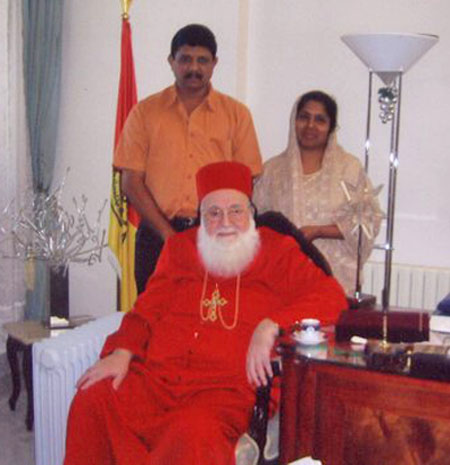 Cheveliar Shibu Mathew Pullolickal and Shirley Mathew with HH Bava encouraged Shibu to continue working for the holy church and blessed both of them. Two months later, he was decorated with the title of Chevalier. Shibu's attitude towards the church has gone into superdrive after that. Currently, in addition to his services to Kottayam Diocese, he also serves the church in the capacities as the Managing Committee member and working committee member. Shirley is very active in Morth Mariam Samajam and takes a lead role in helping poor families. Yes, they were transformed after the encounter with our saintly Moran! When we read through the articles in this souvenir, we learn quite a bit about Bava's role in promoting ecumenical relations with other churches. His work with Catholic Church and Blessed Pope John Paul II is legendary. Catholic Church is known to be very inflexible historically; and they really do not have much to gain by promoting relationship with other churches as they are very big to start with. We should look at the agreement in this light. Moran must have done a great job in inspiring the pope to take this step. Bava has rolled the red carpet for all church heads, big or small, to the Patriarchate; he has never missed an opportunity to help anyone he can. I recently read an article titled "The Inspirable Memories shall not die..." written by The Most Rev Joseph Mar Koorilose, Valiya (Senior) Metropolitan, Malabar Independent Syrian Church (Thozhiyoor) in connection with the Silver Jubilee of Patriarchal Enthronement of the Moran. I like to quote a few sentence from HG's article as it explains what other church heads saw in Moran: His Holiness has been known for his keenness in receiving heads of the other churches and providing them with loving hospitality and assistance with a blessed ecumenical vision. My predecessor H.G. Mathews Mar Koorilose Metropolitan was invited to spend more than one week with His Holiness during the visit of Kerala in 1984-85. I was also cordially welcomed and received by His Holiness during my visit to Damascus in the year 1988. As Moran's guest, I spent three days in Damascus. Moran arranged my travel to visit important places like the Chapel of Ananias where St. Paul was baptized, Church at Omayad where St. John the Baptist's venerable tomb exists, etc., with Moran's then secretary Rev. Fr. K.V. Kuriakose (now H.G. Kuriakose Mar Juliose Metropolitan). After presenting me some gifts including one 'Sleeba' with paternal feelings, H.H. bid farewell to me on that visit on 24th of June 1988.Moran had issued special 'Kalpana' to the vicars (Very Rev. Joseph Verghese Rambban & Rev. Fr. Darly Edappanghattu) of St. Ignatius Jacobite Syrian Orthodox Church at Dubai & Jacobite Churches at Sharja, Alayn, Abu Dhabi & Bahrain, instructing them to provide me with all necessary things for the celebration of Holy Qurbana including Tableeta. By that great kindheartedness of His Holiness, I was able to celebrate regular Holy Qurbana in those churches during my visit in the month of June & July in 1988. By that H.H's blessed prayerful support, again in the year 1995 (July 3rd) & 2003 (March 21st) by God in the heaven prepared me to participate in the Holy Qurbana and deliver sermons at Mar Ignatius Jacobite Syrian Orthodox Church at Dubai. My Successor Metropolitan H.G. Cyril Mar Baselios, was also received in that church in the month of March in 2003. It is to be noted that as a result of H.H.'s foresight, Mar Ignatius Jacobite Syrian Orthodox Church at Dubai got a beautiful church building at Jabal Ali (Dubai).His Holiness's vision is always par excellence in all his accomplishments in field of Ecumenism. As I was taking rest just after a surgery, in the month of September 2004, my successor H.G. Cyril Mar Baselios Metropolitan visited His Holiness during the time of Moran's visit to Kerala and presented a memento.The Social Ministry and Helping the Poor were subjects that were very close to the heart of Moran. During the Iraq crisis, and later the crisis in Syria, many of our faithful lost everything they had and became refugees. Moran took the lead in helping those in the refugee camps with whatever resources he could muster. Of course, the help was provided to everyone without any consideration of race, caste or creed. Helping the poor and downtrodden was always high on Moran's agenda. On October 26, 2005 via Patriarchal bull No: E334/05 and later on September 20, 2007 via Bull No: E292/07, His Holiness founded an organization under the Holy Church named 'St. Ephrem Universal Syriac Orthodox Medical Mission.' SEUSOMM was officially inaugurated by His Holiness Mor Ignatius Zakka 1 Iwas on July 7, 2008 at Damascus, Syria."The spirit of the Lord is upon me because he has anointed me; he has sent me to announce good news to the poor, to proclaim release for prisoners and recovery of sight for blind, to let the broken victims go free to proclaim the year of the Lord's favor."The social ministry of the Church is enshrined in this Nazareth Manifesto. The translation of Nazareth Manifesto into reality is the responsibility of the church. God calls the Church for the cause of the poor, the oppressed and the rejected, to declare the love of God by word and deed. The 122nd Patriarch, His Holiness Ignatius Zakka I Iwas, motivated and guided the Universal Syrian Orthodox Church through his conviction in the Nazareth Manifesto to search for new avenues to announce good news to poor, recovery of sight for the blind and let the broken victims go free. ... 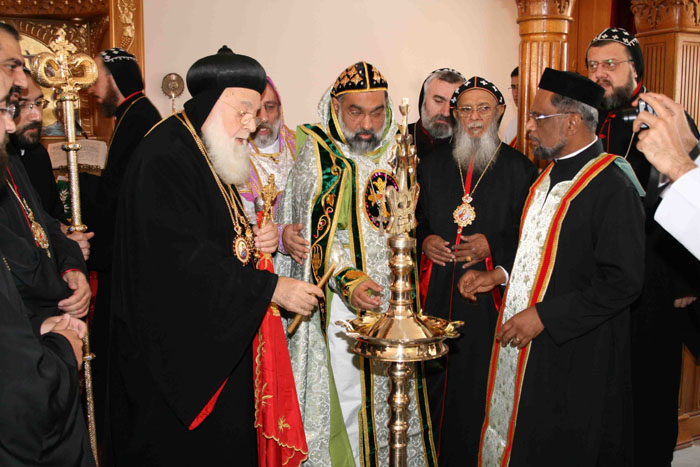 SEUSOMM Inauguration St. Ephrem Universal Syriac Orthodox Mission (SEUSOMM) is the official social ministry of the Holy Church. It has the following objectives: 1. Provide financial, social, and medical assistance to the members of our church who are displaced by war, famine and other calamities in different parts of the world, including immediate attention to those who are in Iraq and those who are left for neighboring countries.2. Establish a Medical Core for immediate deployment to places of need.3. Establish Patriarchal University including a Medical branch at least in places which are now under-served.Holy Father also started The International Syriac Medical Association (ISMA), an Association of Doctors, Nurses and other Medical Professionals in 2010 to help the poor people around the world. ISMA is said to have activities in more than 80 countries. During the inauguration of the St. Ephrem Universal Syriac Orthodox Mission in Damascus, Syria, my cousin Philip Jacob and sister in law Dr. Susan Jacob, MD had a very unexpected and unusual experience with the Moran that they cherish in their hearts. Dr. Susan Jacob is a member of the Executive of the SEUSOMM. They went to Damascus to attend the inauguration. 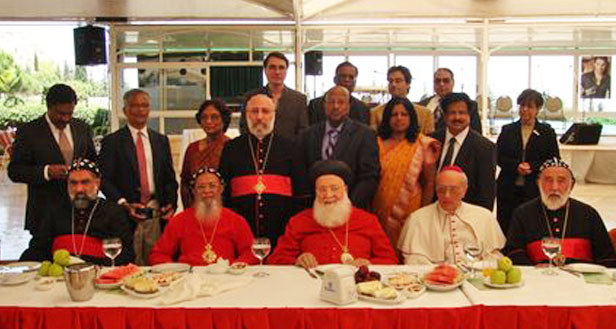 SEUSOMM Board Members and Guests at its Inauguration with HH Zakka I Iwas After the inauguration, Moran was decorating Mr. Chamathil from Dallas, TX with the title of Commander in the presence of HG Joseph Mor Gregorios (Kochu Thirumeni from Kochi), Catholica Bava, and others, a ceremony planned earlier. My cousin and his wife's flight was to leave in less than an hour. Kochu thirumeni introduced my cousin to Bava and told him that he is nominated for the title of Chevaliar by MASOC-NA. Bava said, "I want to make him a Commander." He instructed his assistant to bring all the medals and other documents. This move surprised everyone who were present there. My cousin had to borrow a jacket from another person to wear so bava can pin the medal on him! (His jacket was already packed.) In a rushed ceremony , so they won't miss their flight, Philip Jacob became Commander Philip Jacob! He got transformed in an encounter with our Moran! His Holiness always believed that Christian Faith should produce Good Works since a tree is known by the fruit it produces. (Martin Luther and the reformed church does not believe in works; they teach that salvation comes solely from Grace.) Moran also believed that our works should be directed at the people who need our help most - like poor, sick and suffering. Moran had targeted his efforts at them. In a Lenten Encyclical in 2001, Moran defined what is true faith. Let me quote a passage from this encyclical to get a clear understanding of His Holiness' vision of social ministry. The power of the living Christian faith is made manifest when coupled with good works, its parallel, which, like faith, are necessary for salvation. In this regard, Apostle James asks those who claim they are believers: "What is the use, my brethren, if a man says he has faith, but has not works? Can his faith save him?... You believe that God is one; you do well. The demons also believe, and tremble. Would you know, 0 frail man, that faith without works is dead? Was not Abraham, our father, justified by works, when he offered his son Isaac upon the altar? You see that a man is justified by works, and not by faith alone" (James 2:14-25). ...In his epistle to the Hebrews, Apostle Paul wrote, "For God is not so unjust as to forget your work and labor of love which you showed toward His name, in that you served the Saints and you still do" (Hebrews 6:10).From here we know that the Lord Jesus wants us to serve the saints and His needy brethren and empathize with them. He wants us to look after them, lend a helping hand to the poor, and call on the widows and orphans, considering our service to them a service to the Lord Jesus Himself, for they are His little brethren. We should consider what we do with and to them as if we were doing it to Him. This kind of work is considered to be the heart of the Christian faith, as indicated by Apostle James, "Religion that is pure and undefiled before God the Father is this: to visit the orphans and widows in their affliction, and to keep oneself unstained from the world" (James 1:27). Moreover, mercy is the daughter of love; therefore, he whose heart thrives with love of God, this love shall be manifested in his love for the neighbor. ....It is difficult to summarize the life-long accomplishments of Moran Mor Zakka I Iwas in a short volume. Suffice it to say that he made an impact on everyone he met. Moran's departure is a great loss to our church and to the world. But then we have one more person to intercede for us. May his prayers be a fortress for us. Let me conclude with a quote of bava on prayer: "Prayer is not an attempt to subdue the will of God for our desires, but is always an attempt to subjugate our will to the will of God."Acknowledgements: I want to thank V. Rev. Dr. Kuriakose Corepiscopa Moolayil for permission to excerpt a few articles from His Book, "Festschrist." The photographs of the Funeral Service were provided by SOCMnet. I want to thank Janice Mathew, a new member of Malankara World Team, for her timely help in editing some articles and Rev. Fr. Jose Daniel Paitel, another new member of Malankara World Team, for his assistance in preparing this volume. And, last but not the least, Sunitha Flowerhill for her help as a valuable member of the Malankara World Team. (If you want to see someone bubbling with enthusiasm, it is Sunitha. May be that is after her encounter with the Moran!) Due to the time constraints, this volume had to be prepared in a very short notice. I want to thank Rev. Fr. Paul Thotakat, V. Rev. Abraham O. Kadavil Cor Episcopa and Rev. Fr. Jerry Kurian Kodiattu who rose to the occasion and wrote the articles in spite of their busy schedules. Despite being extremely busy and grieving in Lebanon, Theethose thirumeni had responded, in a timely manner, to my query regarding this volume. Thank you Your Eminence. Thank you all. |
||
|
Features
|
||
|
by HB Baselios Thomas I,
Catholicose and Metropolitan Trustee, Jacobite Syrian Christian Church Supreme Patron, Malankara World 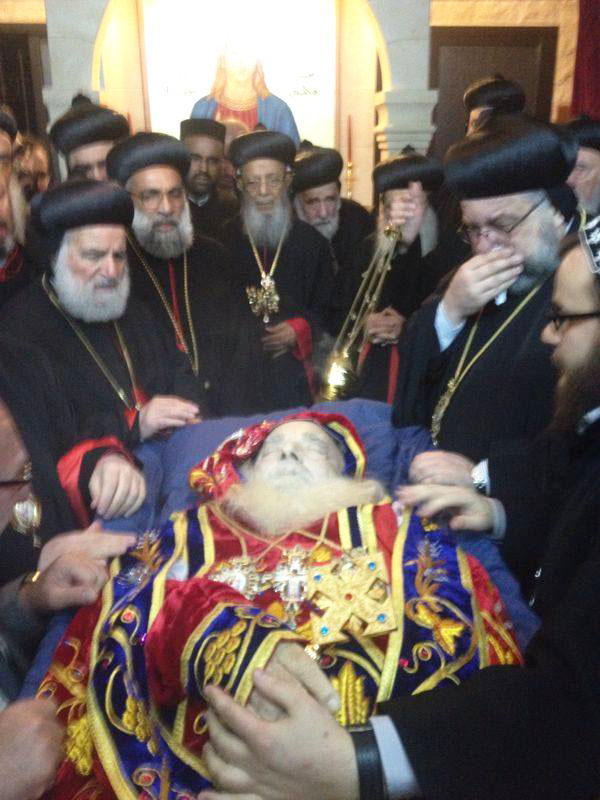 Mortal Remains of LL Moran Mor Ignatius Zakka I Iwas in Lebanon I would like to thank God Almighty for giving us this opportunity to remember in gratitude the life of Moran Mor Ignatius Zakka I Iwas, our LL Patriarch and the Supreme Spiritual Head of our Church, who left for his heavenly abode on March 21, 2014 leaving a vacuum that is impossible to fill in our Holy Church. We have had long association with the Patriarch and have many sweet memories to recollect and cherish. Moran has always been kind and loving to me personally. I have felt the warmth of his love when I was a bishop. Now as Catholicos, I feel it even more. Every time I visited the Patriarch, I was received with affection and love. Perhaps, the greatest expression of Moran's love towards me and confidence in me was my consecration as Catholicos. I shall always be grateful to Moran for granting me this honor and will try to live up to the expectations of His Holiness by doing whatever I can to preserve the true faith and traditions of our Church. With Moran around you, you can always feel heavenly blessings flowing. I have always believed that it is the divine glory in him that is very visibly expressed on his glowing face. It was always a joy to be with Moran and to listen to his sweet voice. Hearing his voice was always a delight. The grace and magnanimity of His Holiness cannot be captured fully in an article or in a few words. We can only grasp a sliver of his saintliness in the words that follow. We remember accompanying His Holiness after his apostolic visit to India in 1982. His Holiness briefed churches everywhere about his visit to Malankara and its faithful people. Moran also visited the then President of Turkey. It was the first visit of a Patriarch of Antioch since Patriarch Elias III to the President of Turkey. In 2000, His Holiness was also blessed by God in being able to offer Holy Eucharist at the site of the ancient Church in Antioch. This was an historic event that came to pass after many centuries. His Holiness Moran Mor Ignatius Zakka I Iwas was installed as Patriarch of Antioch and all the East on September 14, 1980. In the first apostolic address as Patriarch, His Holiness stressed the need for a major seminary of international standard for the Church. With this vision in mind, he bought about 30 acres of land about 20 miles away from Old Damascus in a splendid and picturesque area. This place has now grown into a modern suburb of Damascus with important centers of secular administration, superior lodging facilities, and good residential areas. When I first visited that place after the plot was secured, I could not grasp the farsighted vision of His Holiness in acquiring this piece of land. Now everyone who pays a visit to this place will recognize the care and farsightedness of His Holiness in planning for the future. Today, we see in this place a magnificently built Patriarchal Seminary, in four floors with all facilities including the residence of His Holiness, accommodations for visiting dignitaries, theological students and an in-house chapel. Adjacent to it is a very beautiful cathedral, an auditorium with facilities to hold international conferences, a convent, and a guest house. The whole area is planted with olive trees which add greenery to the architectural perfection of the buildings. A new flat (apartment) complex with an in-house chapel is also built in this area. The development and progress that we see here is not merely the result of a human endeavor but definitely that of a divine inspiration that was shaped by His Holiness. It has enhanced the prestige of the Patriarchate among other ancient sees. 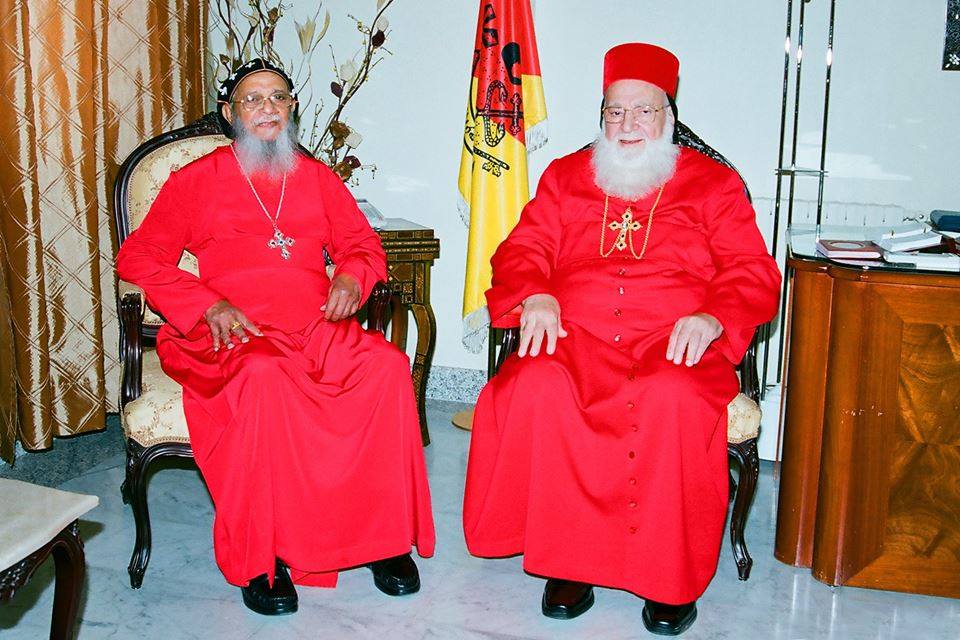 We see the tremendous progress and development of the Church not only in Syria,
but also in countries such as Germany, Holland, Australia, USA, Canada, and
South America. The ancient centers of Syriac Christianity are also witnessing a
resurgence. I wish to mention here in particular the consecration of a
bishop for Jerusalem, where the Syrian Orthodox Church has gained possessions in
the holy city; the consecration of the successor to Mor Chrysostomos Musa Salama
in Brazil, where the Church is developing along with the church in Argentina.
Similarly the consecration of three bishops in North America has helped the
overall development of the Church there. The foresight of His Holiness in
consecrating young bishops has given impetus to the growth and vitality of the
Universal Syrian Orthodox Church. In the Persian Gulf regions as well, His
Holiness has paid visits to the government authorities securing support for the
churches there to procure our own land to build houses of worship. New and
magnificent churches have been built in Dubai, Sharjah, Alain, Bahrain, and
Doha, among other places.
Coming to the situation in India, the Church is rapidly developing despite the
crisis that the church experienced after the demise of the late H.B. Baselius
Poulose II. His Holiness has made four apostolic visits to India, which is
unprecedented in history.
The first apostolic visit in 1982 was very historic and epoch-making. He visited
hundreds of churches and blessed the faithful and the public. His Holiness was
received as state guest by the then government of Kerala.
The second visit was to commemorate the fiftieth consecration jubilee of late
H.E. Mor Clemis Abraham, Chief Metropolitan of the East, in 2000. This visit was
blessed and adorned by the reception of His Holiness among all sections of
people and even by nature herself - the heavy rain that had deluged the state
receded to honor the apostolic visit. The warmth of his love, his divinely
inspired utterances and his saintly countenance attracted people from all walks
of life to him.
In the third visit in 2004, the rival faction in Malankara attempted to create
many hindrances. But His Holiness never uttered a word against the opposing
faction and their partisans. The development of the church during the last
twenty-five years was conspicuous. The overwhelming support of people from all
walks of life was very evident during this visit.
The last visit of Moran to Malankara was in 2008. During that visit, Moran
declared as saints Mor Greegoriose Abdall Jaleel Bava entombed at N. Parur
St. Thomas Church and Mor Paulose Coorilose Metropolitan entombed at St. Mary's
Church at Panampady.
We see the tremendous progress and development of the Church not only in Syria,
but also in countries such as Germany, Holland, Australia, USA, Canada, and
South America. The ancient centers of Syriac Christianity are also witnessing a
resurgence. I wish to mention here in particular the consecration of a
bishop for Jerusalem, where the Syrian Orthodox Church has gained possessions in
the holy city; the consecration of the successor to Mor Chrysostomos Musa Salama
in Brazil, where the Church is developing along with the church in Argentina.
Similarly the consecration of three bishops in North America has helped the
overall development of the Church there. The foresight of His Holiness in
consecrating young bishops has given impetus to the growth and vitality of the
Universal Syrian Orthodox Church. In the Persian Gulf regions as well, His
Holiness has paid visits to the government authorities securing support for the
churches there to procure our own land to build houses of worship. New and
magnificent churches have been built in Dubai, Sharjah, Alain, Bahrain, and
Doha, among other places.
Coming to the situation in India, the Church is rapidly developing despite the
crisis that the church experienced after the demise of the late H.B. Baselius
Poulose II. His Holiness has made four apostolic visits to India, which is
unprecedented in history.
The first apostolic visit in 1982 was very historic and epoch-making. He visited
hundreds of churches and blessed the faithful and the public. His Holiness was
received as state guest by the then government of Kerala.
The second visit was to commemorate the fiftieth consecration jubilee of late
H.E. Mor Clemis Abraham, Chief Metropolitan of the East, in 2000. This visit was
blessed and adorned by the reception of His Holiness among all sections of
people and even by nature herself - the heavy rain that had deluged the state
receded to honor the apostolic visit. The warmth of his love, his divinely
inspired utterances and his saintly countenance attracted people from all walks
of life to him.
In the third visit in 2004, the rival faction in Malankara attempted to create
many hindrances. But His Holiness never uttered a word against the opposing
faction and their partisans. The development of the church during the last
twenty-five years was conspicuous. The overwhelming support of people from all
walks of life was very evident during this visit.
The last visit of Moran to Malankara was in 2008. During that visit, Moran
declared as saints Mor Greegoriose Abdall Jaleel Bava entombed at N. Parur
St. Thomas Church and Mor Paulose Coorilose Metropolitan entombed at St. Mary's
Church at Panampady.
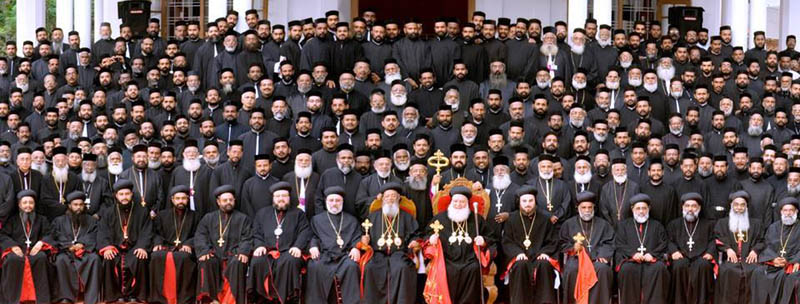 We gratefully cherish the love and care of His Holiness for the Church in
Malankara from the time of his consecration. The growth and development of our
seminary here is also a witness to the care of His Holiness made evident to the
Church in Malankara.
The Church in Malankara was blessed by the Patriarchal consecration ceremony
officiated by the late H.B. Baselius Poulose II. It was for the first time in
the history of the Church that an Indian prelate officiated at the consecration
ceremony of a Patriarch of Antioch. His prayerful and thoughtful actions and
interventions in the affairs of the Church in Malankara proves beyond doubt that
the steps taken by His Holiness were guided by God and were well received and
appreciated by all sections of the faithful in the Church as well as others in
the society.
We gratefully cherish the love and care of His Holiness for the Church in
Malankara from the time of his consecration. The growth and development of our
seminary here is also a witness to the care of His Holiness made evident to the
Church in Malankara.
The Church in Malankara was blessed by the Patriarchal consecration ceremony
officiated by the late H.B. Baselius Poulose II. It was for the first time in
the history of the Church that an Indian prelate officiated at the consecration
ceremony of a Patriarch of Antioch. His prayerful and thoughtful actions and
interventions in the affairs of the Church in Malankara proves beyond doubt that
the steps taken by His Holiness were guided by God and were well received and
appreciated by all sections of the faithful in the Church as well as others in
the society.
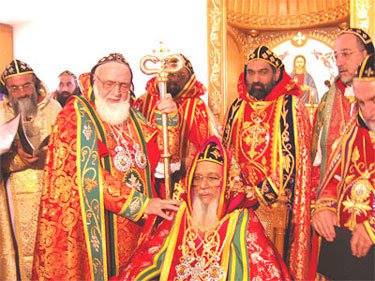 The exemplary manner in which His Hhttp://wwwoliness implemented administrative measures
was
particularly evident when we consider the patience and prudence that he showed
in the turmoil of Malankara affairs. In 2002, I personally witnessed the utmost
care and planning that preceded the consecration of the Catholicos. His Holiness
personally contacted all bishops of the Universal Syriac Orthodox Church and engaged in
appropriate legal consultations right up to the event to ensure validity and
flawless conduct of the consecration. H.G. Mor Gregorios Joseph, the secretary
of the Holy Synod of Malankara Church, was there with the other Church leaders
to witness this historic event. To save the Church in Malankara, His Holiness
consecrated four more Metropolitans and arranged to consecrate another
Metropolitan in India itself. His Holiness consecrated Holy Chrism for Malankara
during his third visit and blessed the Church here. I have had the privilege of
being received by His Holiness in Damascus many times and I have admired his
planning and his attention to detail in all actions and initiatives.
His Holiness was very keen on encouraging the youth of the Church in all fields
of activities. Young deacons were sent to the different parts of the world for
higher studies in theology; young educated monks were consecrated as archbishops,
new archbishoprics were established and the youth are kept close and loyal to the
church. His Holiness very keenly attended to all faithful of the Church
scattered all over the world and was aware of the needs and necessities of the
Church in this age.
His Holiness is honored wherever he visited. Many countries greeted him as state
guests, Christian Churches received him as a man of God, the World Council of
Churches honored him as one of its Presidents, the Pro Oriente Foundation,
Vienna, venerated him as its Protector, and the children of the Syrian Orthodox
Church followed him as their spiritual Pontiff.
May his prayers be fortress to us all.
The exemplary manner in which His Hhttp://wwwoliness implemented administrative measures
was
particularly evident when we consider the patience and prudence that he showed
in the turmoil of Malankara affairs. In 2002, I personally witnessed the utmost
care and planning that preceded the consecration of the Catholicos. His Holiness
personally contacted all bishops of the Universal Syriac Orthodox Church and engaged in
appropriate legal consultations right up to the event to ensure validity and
flawless conduct of the consecration. H.G. Mor Gregorios Joseph, the secretary
of the Holy Synod of Malankara Church, was there with the other Church leaders
to witness this historic event. To save the Church in Malankara, His Holiness
consecrated four more Metropolitans and arranged to consecrate another
Metropolitan in India itself. His Holiness consecrated Holy Chrism for Malankara
during his third visit and blessed the Church here. I have had the privilege of
being received by His Holiness in Damascus many times and I have admired his
planning and his attention to detail in all actions and initiatives.
His Holiness was very keen on encouraging the youth of the Church in all fields
of activities. Young deacons were sent to the different parts of the world for
higher studies in theology; young educated monks were consecrated as archbishops,
new archbishoprics were established and the youth are kept close and loyal to the
church. His Holiness very keenly attended to all faithful of the Church
scattered all over the world and was aware of the needs and necessities of the
Church in this age.
His Holiness is honored wherever he visited. Many countries greeted him as state
guests, Christian Churches received him as a man of God, the World Council of
Churches honored him as one of its Presidents, the Pro Oriente Foundation,
Vienna, venerated him as its Protector, and the children of the Syrian Orthodox
Church followed him as their spiritual Pontiff.
May his prayers be fortress to us all.
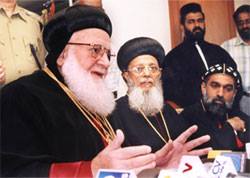 + Baselios Thomas I Catholicos
+ Baselios Thomas I Catholicos(Transcribed from an interview by Very Rev. Kuriakose Moolayil at Kothamangalam) Source: The Fetschrift in Honor of His Holiness Ignatius Zakka I Iwas, Sept 14, 2005, V. Rev. Dr. Kuriakose Moolayil Corepiscopos (editor) Used with Permission |
||
|
by His Eminence Yeldo Mor Theethose
Archbishop and Patriarchal Vicar, Malankara Archdiocese of The Syriac Orthodox Church in N. America Patron, Malankara World 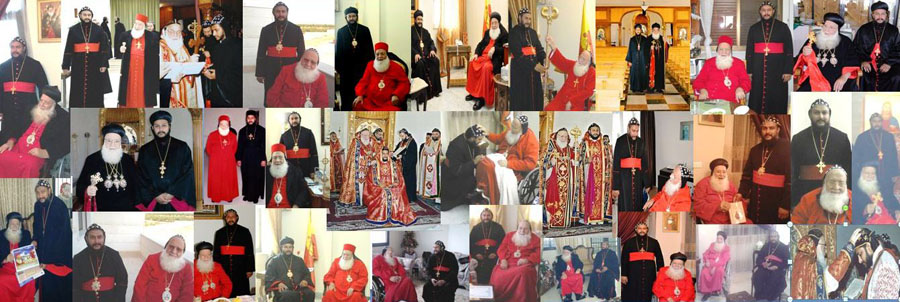 I feel extremely lucky and honored to have been mentored and guided by my
spiritual father, LL Moran Mor Ignatius Zakka I Iwas, Patriarch of Antioch and
All The East and the Supreme Head of the Universal Syriac Orthodox Church. With
the departure of my spiritual father, I truly feel like an orphan. This is a
big loss to all of us in the Syriac Orthodox Church as well as to the Christian
World overall. Let me explain why.
His Holiness was enthroned as the Patriarch of Antioch and All the East on
September 14, 1980. Ever since he took over the leadership, the Syrian Orthodox
Church has been on the path of steady progress. His task as the supreme head of
a universal church, in the midst of countless number of denominations around the
world, is never easy. Still it is the clarity of his vision and the commitment
to his mission that has helped the Church to flourish all over the world. Today
the Church has its presence in both in the East and the West and it is
shepherded by 70 Metropolitans, including His Beatitude the Catholicos who
functions under the Patriarch. His Holiness is very keen on promoting
theological education among clergy. He explores each and every possibility for
higher education, wherever possible, and sends suitable candidates there. As a
result, today we have several of our clergy doing their theological studies in
seminaries all over the world. Moran's contributions to the Ecumenical world are
indeed commendable. It is a matter of honor and pride for the Church that His
Holiness is one of the Presidents of the World Council of Churches.
My personal memory about His Holiness goes back to the day when I received the
Apostolic Order from His Holiness, inviting me to Syria for theological studies,
which changed my life altogether. From the first day of my arrival in Damascus,
Moran made sure that I was well taken care of, even though I was just a deacon
at that time. I still remember Moran sending special cakes from Damascus to
celebrate my birthday in our Seminary at Ma'arat Saydnaya which is about 27 km
away from the city. I had several opportunities to hear great things about our
Moran Patriarch from those who came to visit His Holiness. His loving and caring
approach to each and every person, his consoling words, paternal advice, and his
mere presence are always a solace to every one.
I feel extremely lucky and honored to have been mentored and guided by my
spiritual father, LL Moran Mor Ignatius Zakka I Iwas, Patriarch of Antioch and
All The East and the Supreme Head of the Universal Syriac Orthodox Church. With
the departure of my spiritual father, I truly feel like an orphan. This is a
big loss to all of us in the Syriac Orthodox Church as well as to the Christian
World overall. Let me explain why.
His Holiness was enthroned as the Patriarch of Antioch and All the East on
September 14, 1980. Ever since he took over the leadership, the Syrian Orthodox
Church has been on the path of steady progress. His task as the supreme head of
a universal church, in the midst of countless number of denominations around the
world, is never easy. Still it is the clarity of his vision and the commitment
to his mission that has helped the Church to flourish all over the world. Today
the Church has its presence in both in the East and the West and it is
shepherded by 70 Metropolitans, including His Beatitude the Catholicos who
functions under the Patriarch. His Holiness is very keen on promoting
theological education among clergy. He explores each and every possibility for
higher education, wherever possible, and sends suitable candidates there. As a
result, today we have several of our clergy doing their theological studies in
seminaries all over the world. Moran's contributions to the Ecumenical world are
indeed commendable. It is a matter of honor and pride for the Church that His
Holiness is one of the Presidents of the World Council of Churches.
My personal memory about His Holiness goes back to the day when I received the
Apostolic Order from His Holiness, inviting me to Syria for theological studies,
which changed my life altogether. From the first day of my arrival in Damascus,
Moran made sure that I was well taken care of, even though I was just a deacon
at that time. I still remember Moran sending special cakes from Damascus to
celebrate my birthday in our Seminary at Ma'arat Saydnaya which is about 27 km
away from the city. I had several opportunities to hear great things about our
Moran Patriarch from those who came to visit His Holiness. His loving and caring
approach to each and every person, his consoling words, paternal advice, and his
mere presence are always a solace to every one.
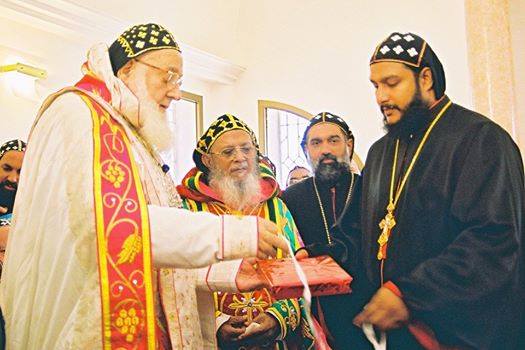 During my stay in Damascus I had a chance to visit a person who was working in
the Middle East Council of Churches, who said: "Your Patriarch is the best" and
I asked him why he thought so. He replied thus: "His innocent face, loving heart
and his lofty thinking... And I love him very much". I am sure, this was not
flattery. Whoever has met or encountered with our Patriarch has always some
thing great to talk about his personality. I have seen many people, even bishops
from India approaching Moran with all sorts of issues. All of them have told me
that our Moran is a treasury of wisdom and consolation and they all had some
thing to learn from His Holiness. Like in the stories of the Desert Fathers,
some of them used to say, "it is enough for us to just watch His Holiness' face"
I consider myself very much blessed, to experience personally, the paternal love
and care from His Holiness and I record my gratitude for the same. Being the
only person from Malankara to have received five ordinations from the Patriarch,
that is, from Subdeacon (aufadiakno) to Archbishop, I am honored in writing this
prayerful tribute to LL His Holiness the Patriarch Ignatius Zakka I Iwas.
May his intercessions be a fortress to all of us.
+ Archbishop Mor Theethose Yeldho
Adapted from The Fetschrift in Honor of His Holiness Ignatius Zakka I Iwas,
During my stay in Damascus I had a chance to visit a person who was working in
the Middle East Council of Churches, who said: "Your Patriarch is the best" and
I asked him why he thought so. He replied thus: "His innocent face, loving heart
and his lofty thinking... And I love him very much". I am sure, this was not
flattery. Whoever has met or encountered with our Patriarch has always some
thing great to talk about his personality. I have seen many people, even bishops
from India approaching Moran with all sorts of issues. All of them have told me
that our Moran is a treasury of wisdom and consolation and they all had some
thing to learn from His Holiness. Like in the stories of the Desert Fathers,
some of them used to say, "it is enough for us to just watch His Holiness' face"
I consider myself very much blessed, to experience personally, the paternal love
and care from His Holiness and I record my gratitude for the same. Being the
only person from Malankara to have received five ordinations from the Patriarch,
that is, from Subdeacon (aufadiakno) to Archbishop, I am honored in writing this
prayerful tribute to LL His Holiness the Patriarch Ignatius Zakka I Iwas.
May his intercessions be a fortress to all of us.
+ Archbishop Mor Theethose Yeldho
Adapted from The Fetschrift in Honor of His Holiness Ignatius Zakka I Iwas, Sept 14, 2005, V. Rev. Dr. Kuriakose Moolayil Corepiscopos (editor) |
||
|
By Babu, Thumpayil
|
||
|
by Rev. Fr. Paul Thotakat 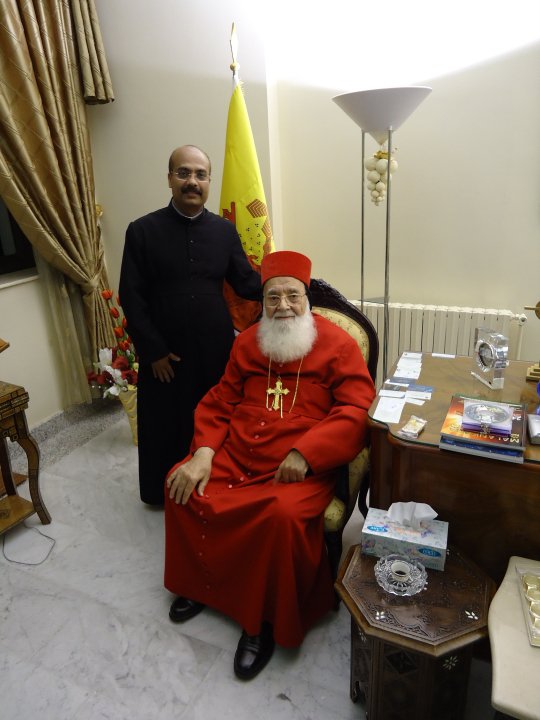 Fr. Thotakat with Holy Father His Holiness Moran Mor Ignatius Zakka I Iwas left the mortal body sweetly and divinely on March 23, 2014. "Three things will last forever--faith, hope, and love--and the greatest of these is love."I was and still am motivated spiritually by what I saw and heard some four years ago. I was part of a delegation from North America to meet with our beloved Patriarch in Damascus, Syria. We were welcomed by the warm hospitality of Rev. Dn. Joshi (Now Fr. Joshi) was complemented by a pervasive sense of spiritual warmth in His Holiness. We spent almost a week there. I came to know personally that the Holy Father was a person of grace, power and presence who lived a life of deep devotion to God. With generosity, humility, and sensitivity, our spiritual Father answered our call for support with a touch of reassurance, other times taking firm hold in a challenging situation. We had several sessions with Bava during this visit. Moran listened with rapt attention as we described our passion for helping candidates for ordained ministry in North America. His eyes gleamed with joy. We realized that Bava tenaciously, disregarding his poor health, was still bringing up the faithful from Malankara and their future generations and many others before God's throne. Moran worked with us with great patience and limitless encouragement. Bava very eloquently and concisely could phrase the need for protection of faith for future generations. Bava inspired us to develop a love and caring for our children growing up outside the countries from their parents origin. Holy Father knew – and communicated – that, what was at the heart of taking care of the Church is, loving the Church. People who only knew him personally in his senior years knew that the joy and peace which truly radiated from Moran as he sat quietly in his chair in the office was the result of a lifetime of making good choices and wise decisions in accordance with God's Word. Bava was simply "a tree planted by the streams of living water that yielded fruit in season." Holy Father was a brilliant light, and what he radiated was Love. That heart was open and welcoming, and we were all drawn to its nectar. The most common comment from anyone who spends time at Patriarchal Aramana was that they wished they had more time with His Holiness. Holy Father's love lives on and expands as it is carried in so many hearts. Bava impacted generations of the faithful in the Church, not only with the command of Christian doctrines but also personal commitment of a true shepherd to the flock. From early childhood until HH took the last breath, the magnificent Spirit that he is, Bava epitomized the definition of a "Holy man." It is easy to associate quietness, self-deprecation and even-temperedness, with genuine spirituality, and, of course, these charming character qualities, which Christians and teachers so readily venerate, are analogous to fruits of the Spirit. To the degree that we are able to discern these things, he was the quintessential Spirit-filled Christian. Which of the nine fruits of the Spirit do you not associate with him: love, peace, forbearance, kindness, goodness, faithfulness, gentleness, and self-control? All of them were hallmarks of his character. Bava is the true definition of a Christian and His love for teaching is absolutely contagious. Throughout the years, Bava has graciously shared his knowledge of God, relationship with Almighty. By God's grace, Moran's legacy will last into the future generations; there will be multitudes, in the years to come, who will be anxious to build faithfully on the foundation he laid for those who followed him. Bava will greatly be missed, but his legacy will indubitably live on. Heaven is shining a little brighter now, but our world is dimmer without Bava. It calls for us to depend on God that much more and understand that He has a plan and there's a time and a season for everything and everyone. HH's love and compassion for our diocese – " Malankara Archdiocese of North America" was unparalleled. We were honored to hear his heart about the faithful in this part of the world and the challenges we encounter and advised us to meet them with fortitude. I strive to be the Christian that HH was and to communicate Gospel truth with conviction and excellence. Today we give special tribute to beloved Bava for his legacy of sincere, genuine spirituality which remains a fragrance in our church. Therefore, respectfully, lovingly, even reverently we say a temporary and temporal farewell to an esteemed father and spiritual model. I pray that GOD will encamp His angels around you and give you peace that surpasses all understanding. Moran, You were such a blessing to this world. A man of brilliance, wisdom and compassion, you will forever be a role model to our One, Holy, Catholic, and Apostolic Church. With Love, Prayers, and Gratitude, -Fr. Paul Thotakat |
||
|
by Very Rev. Abraham O. Kadavil Cor Episcopa
And I tell you that you are Peter, and on this rock I will build my church, and the gates of Hades will not overcome it. I will give you the keys of the kingdom of heaven; whatever you bind on earth will be bound in heaven, and whatever you loose on earth will be loosed in heaven."LL HH Ignatius Zakka I Iwas, as the 122nd reigning Syriac Orthodox Patriarch of Antioch and All the East and the Supreme Head of the Universal Syriac Orthodox Church, inherited those keys, preserved that rock and the church entrusted to him by his Master and shepherd it the way that was pleasing to his Master. May the prayers of the Moran be a fortress for us. |
||
|
By Rev. Fr. Jerry Kurian Kodiattu
|
||
|
by Janice Mathew "Remember your leaders who taught you the word of God. Think of all the good that has come from their lives, and follow the example of their faith." Hebrews 13:7  As a small girl, I always remember being so overwhelmed by the presence of our
beloved Holy Father and over the years His Holiness engraved a very special
place in my heart which words cannot sincerely articulate at this somber moment.
Our first meeting was at the early age of three and a half then again at age
four for the occasion of my little brother's baptism. Of course at that age, I
couldn't quite comprehend the enormity of meeting His Holiness our Patriarch yet
something deep inside my soul was ignited. I always enjoyed browsing the
photographs of the times our spiritual father came to visit our hometown of
Dallas, Texas and hearing my father, Very Rev. Joseph C. Joseph Corepiscopas'
joyful sharing of those memorable six days. I remember the paternal softness of
our beloved Holy Father as my brother cried during his baptism, stroking his
back during the Holy Sacrament to soothe the young boy as he was being held in
the hands of Late Lamented His Eminence Athanasius Yeshue Samuel, our first
Archbishop. With age I found myself intrigued by His Holiness, reading up on all
the articles available in print in various magazines and publications and always
looking forward to hearing the Christmas and Easter messages. Being 1000s of
miles away from us, this was my means of remaining close to His Holiness.
Over the years, time and time again those that visited our beloved Moran would
exclaim of His Holiness' humility, love, kindness and compassion of all our
people of various walks of life. The more I heard of our nurturing spiritual
father, the more I felt I wanted to stay near him. In the last several years
with FaceBook, YouTube, and internet resources I felt closeness to our Patriarch
through videos, articles, and photos. My heart yearned to learn more about our
Holy Father. I remember visiting Theethose Thirumeni with my family once and
seeing a magazine on the table featuring an interview with His Holiness. As
Achen and Thirumeni exchanged pleasantries and caught up, I was studying the
pictures and immersed in our Holy Father's words.
It wasn't until September of 2010 that the paternal love and blessings I
experienced came full circle. I recall when my 4 year old son, Jacob and Fr.
Bijo, by God's grace and goodness visited the Patriarch to celebrate His
Holiness' 30th Patriarchal consecration anniversary. On the last day of the trip
I received a phone call... "Jan you probably won't believe me but we met H.H.
three times and Jacob was scared all three times but when we went to say goodbye
H.H. leaned over blessing Jacob and said 'I love you Jacob' and kissed him". I
thought to myself this Holy Father ranking highest among mortals takes notice of
my little one not just as a passerby but took him in as a grandfather would and
extended himself over and over to ensure he was comfortable. All that have been
in the presence of His Holiness will testify the same over and over again.
As a small girl, I always remember being so overwhelmed by the presence of our
beloved Holy Father and over the years His Holiness engraved a very special
place in my heart which words cannot sincerely articulate at this somber moment.
Our first meeting was at the early age of three and a half then again at age
four for the occasion of my little brother's baptism. Of course at that age, I
couldn't quite comprehend the enormity of meeting His Holiness our Patriarch yet
something deep inside my soul was ignited. I always enjoyed browsing the
photographs of the times our spiritual father came to visit our hometown of
Dallas, Texas and hearing my father, Very Rev. Joseph C. Joseph Corepiscopas'
joyful sharing of those memorable six days. I remember the paternal softness of
our beloved Holy Father as my brother cried during his baptism, stroking his
back during the Holy Sacrament to soothe the young boy as he was being held in
the hands of Late Lamented His Eminence Athanasius Yeshue Samuel, our first
Archbishop. With age I found myself intrigued by His Holiness, reading up on all
the articles available in print in various magazines and publications and always
looking forward to hearing the Christmas and Easter messages. Being 1000s of
miles away from us, this was my means of remaining close to His Holiness.
Over the years, time and time again those that visited our beloved Moran would
exclaim of His Holiness' humility, love, kindness and compassion of all our
people of various walks of life. The more I heard of our nurturing spiritual
father, the more I felt I wanted to stay near him. In the last several years
with FaceBook, YouTube, and internet resources I felt closeness to our Patriarch
through videos, articles, and photos. My heart yearned to learn more about our
Holy Father. I remember visiting Theethose Thirumeni with my family once and
seeing a magazine on the table featuring an interview with His Holiness. As
Achen and Thirumeni exchanged pleasantries and caught up, I was studying the
pictures and immersed in our Holy Father's words.
It wasn't until September of 2010 that the paternal love and blessings I
experienced came full circle. I recall when my 4 year old son, Jacob and Fr.
Bijo, by God's grace and goodness visited the Patriarch to celebrate His
Holiness' 30th Patriarchal consecration anniversary. On the last day of the trip
I received a phone call... "Jan you probably won't believe me but we met H.H.
three times and Jacob was scared all three times but when we went to say goodbye
H.H. leaned over blessing Jacob and said 'I love you Jacob' and kissed him". I
thought to myself this Holy Father ranking highest among mortals takes notice of
my little one not just as a passerby but took him in as a grandfather would and
extended himself over and over to ensure he was comfortable. All that have been
in the presence of His Holiness will testify the same over and over again.
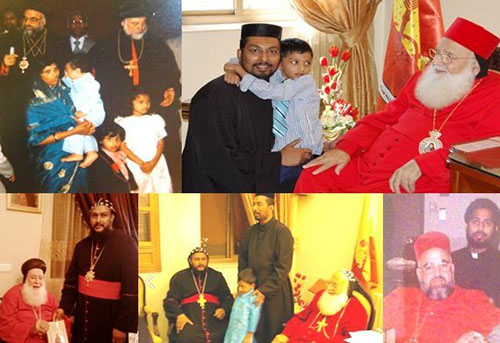 For weeks after the trip Jacob and Achen could not say enough about His
Holiness. How simple, humble and saintly he is. The gentleness of his beautiful
smile and heavenly grace that would heal any heart or brighten any day! The
sharing of the story of how an insect bite at a very young age transformed to
the cross on His Holiness' left cheek. Children very eagerly kissing the special
spot to receive blessings. Over and over Achen would share how much our
Patriarch loves Theethose Thirumeni and the American Archdiocese testifying that
this was one of the most memorable experiences of his life.
Our faithful around the world referred to His Holiness as a "living saint
because of the Christ like qualities he exuded. Regardless of whether you are a
lay man, woman, child, dignitary, clergy he always welcomed all with the same
genuine love, care and concern. These days humility and love are lost virtues.
Our dear Holy Father is the only Patriarch my generation has known serving us
over thirty three years. Bava is truly a very amazing man and this world, our
Church, our people are experiencing a painfully tremendous loss.
Indeed our beloved has left us but we take solace in knowing the prayers and
intercession will carry us through to eternity.
We love you, we miss you, and forever cherish the blessing of calling you our
Holy Father.
For weeks after the trip Jacob and Achen could not say enough about His
Holiness. How simple, humble and saintly he is. The gentleness of his beautiful
smile and heavenly grace that would heal any heart or brighten any day! The
sharing of the story of how an insect bite at a very young age transformed to
the cross on His Holiness' left cheek. Children very eagerly kissing the special
spot to receive blessings. Over and over Achen would share how much our
Patriarch loves Theethose Thirumeni and the American Archdiocese testifying that
this was one of the most memorable experiences of his life.
Our faithful around the world referred to His Holiness as a "living saint
because of the Christ like qualities he exuded. Regardless of whether you are a
lay man, woman, child, dignitary, clergy he always welcomed all with the same
genuine love, care and concern. These days humility and love are lost virtues.
Our dear Holy Father is the only Patriarch my generation has known serving us
over thirty three years. Bava is truly a very amazing man and this world, our
Church, our people are experiencing a painfully tremendous loss.
Indeed our beloved has left us but we take solace in knowing the prayers and
intercession will carry us through to eternity.
We love you, we miss you, and forever cherish the blessing of calling you our
Holy Father.
|
||
|
By Rev. Fr. Jose Daniel Paitel 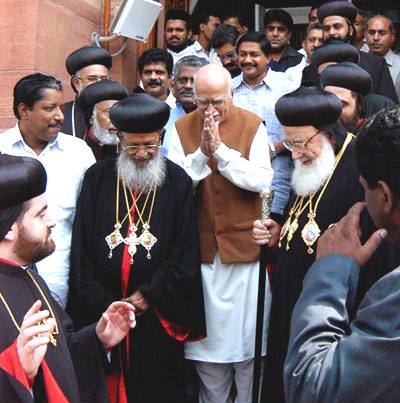 Patriarch Mor Zakka I made an earnest effort to visit his flock worldwide with
highlights including: visiting Malankara five times – in 1964, 1982, 2000, 2004,
and 2008. H.H. visited the faithful in North America 4 times - 1981,1986, 1994,
and 2000. During his apostolic visit in 1994, Moran Zakka I consecrated St.
Mary's Church, Los Angeles. So, this Church has the distinction of being the
only Malankara Church in the United States to be consecrated by H.H. Patriarch
Mor Ignatius Zakka I.
Moran took the initiative of visiting and developing relationships with world
Christian religious heads. He went to their Church headquarters and initiated
dialogues. This helped them to get to know each other and develop ecumenical
cooperation. For example, his visits to Pope John Paul II resulted in a
historical agreement between the two churches in receiving sacraments from each
other. Emboldened by this success, H.H. extended his ecumenical efforts to the
Greek Orthodox Church successfully.
After Patriarch St. Severus (+ 538) was forced to leave Antioch in 518, there
are only a couple of occasions in which a Patriarch has been able to return to
Antioch. His Holiness Moran Mor Zakka I made history by celebrating divine
liturgy at the first church established by St. Peter at Antioch on April 2,
2000.
H.H. Malankara Legacy
Moran is perhaps most remembered in Malankara for his discovery of the Holy
Relics of St. Thomas. The discovery of the Holy Relics took place during the
construction of St. Thomas Church in Mosul. Moran presented a part of them to
the Old Seminary in Kottayam in 1964 and to Mulanthuruthy Marthoman Church in
2004.
Patriarch Moran Zakka1 made several bold changes to the liturgy in the Malankara
Church. H.H. added the name of St. Thomas in the fourth Diptych of Holy Qurbana.
This was warmly welcomed by all faithful in Kerala as St. Thomas is the disciple
who travelled to India to teach and spread Christianity. He is considered the
guardian angel to many. So, this action by Moran will be written in the golden
annals of Church history. H.H. declared Moran Mor Ignatius Elias 3rd, the
patriarch entombed in Manjinikkara, Kerala India (Malankara) as a Saint and
added his name in the fifth diptych. He declared several saints, including St.
Yeldho Mor Baselios Bava (Kothamangalam), Mor Zakralla baseliose bava (Kandanadu),
St. Mor Greegoriose Abdal Jaleel Bava (N Parur), St. Mor Sleeba Mor Osthathios
Bava (Kunnamkulam), Mor Youyakkim Koorilose Bava (Mulanthuruthy), St. Mor
Gregoriose Gheevarghese (Parumala Thirumeni), St. Mor Paulose Athanasiose (Alwaye
Trikunnathu Seminary) and St. Mor Paulose Mor Coorilose. HH authorized
remembering the names of all these saints in the Fifth diptych.
Patriarch Mor Zakka I made an earnest effort to visit his flock worldwide with
highlights including: visiting Malankara five times – in 1964, 1982, 2000, 2004,
and 2008. H.H. visited the faithful in North America 4 times - 1981,1986, 1994,
and 2000. During his apostolic visit in 1994, Moran Zakka I consecrated St.
Mary's Church, Los Angeles. So, this Church has the distinction of being the
only Malankara Church in the United States to be consecrated by H.H. Patriarch
Mor Ignatius Zakka I.
Moran took the initiative of visiting and developing relationships with world
Christian religious heads. He went to their Church headquarters and initiated
dialogues. This helped them to get to know each other and develop ecumenical
cooperation. For example, his visits to Pope John Paul II resulted in a
historical agreement between the two churches in receiving sacraments from each
other. Emboldened by this success, H.H. extended his ecumenical efforts to the
Greek Orthodox Church successfully.
After Patriarch St. Severus (+ 538) was forced to leave Antioch in 518, there
are only a couple of occasions in which a Patriarch has been able to return to
Antioch. His Holiness Moran Mor Zakka I made history by celebrating divine
liturgy at the first church established by St. Peter at Antioch on April 2,
2000.
H.H. Malankara Legacy
Moran is perhaps most remembered in Malankara for his discovery of the Holy
Relics of St. Thomas. The discovery of the Holy Relics took place during the
construction of St. Thomas Church in Mosul. Moran presented a part of them to
the Old Seminary in Kottayam in 1964 and to Mulanthuruthy Marthoman Church in
2004.
Patriarch Moran Zakka1 made several bold changes to the liturgy in the Malankara
Church. H.H. added the name of St. Thomas in the fourth Diptych of Holy Qurbana.
This was warmly welcomed by all faithful in Kerala as St. Thomas is the disciple
who travelled to India to teach and spread Christianity. He is considered the
guardian angel to many. So, this action by Moran will be written in the golden
annals of Church history. H.H. declared Moran Mor Ignatius Elias 3rd, the
patriarch entombed in Manjinikkara, Kerala India (Malankara) as a Saint and
added his name in the fifth diptych. He declared several saints, including St.
Yeldho Mor Baselios Bava (Kothamangalam), Mor Zakralla baseliose bava (Kandanadu),
St. Mor Greegoriose Abdal Jaleel Bava (N Parur), St. Mor Sleeba Mor Osthathios
Bava (Kunnamkulam), Mor Youyakkim Koorilose Bava (Mulanthuruthy), St. Mor
Gregoriose Gheevarghese (Parumala Thirumeni), St. Mor Paulose Athanasiose (Alwaye
Trikunnathu Seminary) and St. Mor Paulose Mor Coorilose. HH authorized
remembering the names of all these saints in the Fifth diptych.The first Ecclesiastical visit to India was an important event in the history of our Church. Mor Abraham Severiose Metropolitan was consecrated during this Apostolic Visit. The consecration of Holy Mooron at St. Mary's Jacobite Syrian Church, Manarcadu was another important event that took place during that visit. Regardless of faith, religion, caste, or creed, general populace from every walks of life enjoyed the holy visitation of Holy Moran. H.H. repeatedly proclaimed his love and affection towards the diversity and unity of Indian culture, and other religions of India. H.H. expressed his integrity toward Indian constitution, Freedom struggle, The Great Mahatma Gandhi, the Father of our nation, Sri Jawahar Lal Nehru, in almost all of his speeches. Moran appreciated The Prime Minister of India, Smt. Indira Gandhi, and The President of India in several occasions. India Government and Kerala Government decorated him as a state guest all throughout the Apostolic visits. The government provided VIP travel arrangements for Holy Moran. A special Police force was deputed for the personal safety of His Holiness. Mr. Sibi Mathew, a young and energetic IPS officer in the Rank of Supdt. of Police led a team of police including Deputy Supdt, Circle Inspectors, Sub Inspectors and constables and a convoy of police vehicles were assigned to protect the Moran during his apostolic visitation. Their devoted service was appreciable and un comparable. Throughout the entire period they were not able to take their timely food. Surprisingly they hesitated even to smoke from respect of Moran. I was humbled to play a leading role during His Holiness two consecutive visits of 1982 and 2000. I was fortunate to enjoy a close interaction with Moran. On several occasions, I was privileged to hold his apostolic staff. In 1982, at a reception at Mezhuvely St. George Salem Jacobite Syrian Church, I translated the speeches of other speakers to English so Moran can understand them. While I was translating I couldn't find an appropriate word for Aranmula kannaadi presented to Holy Moran by the Aranmula Panchayath president as a gift. I described it as a Metal Mirror; while opening the cover, the image of Moran was reflected on it. Moran thought it was a Photo. So Moran said "Photo, Photo" two times. I told Moran, "Moran, it is not a Photo. It is a metal mirror. It is an ancient craft made up of bell metal and polished and glazed with secret herbal mix technology known only to one family." Later I came to know that metal mirror was the appropriate word to describe Aranmula kannadi. I believe, I was inspired by his presence and blessings to use the right terminology. A gift of the tongue blessed the disciples when they spoke. As the Universal Syriac Orthodox Church of Antioch and All The East observes a bereavement period for the departed Supreme Head and Pontiff let us take this time to reflect on his many achievements and effect on the Holy Church and beyond. Moran was a blessed pontiff of our times and became a legend of his time and for upcoming generations. May his prayer be a fortress to our Church and our generations to come. 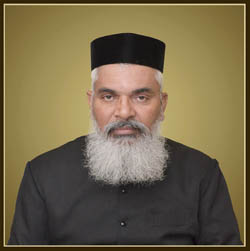 Rev. Fr. Jose Daniel Paitel |
||
|
by V. Rev. Fr. Dr. Kuriakose Corepiscopa Moolayil
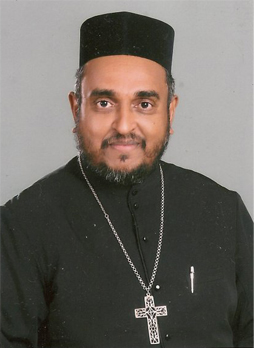 Kuriakose Corepiscopa Moolayil |
||
|
by Sunitha Jijo Flowerhill വെണ്പ്രഭാവം ജ്വലിക്കും മുഖം... വിശ്വശാന്തിക്കാത്മാവു ബലി നല്കി... വാഴ്കെ വാണൊരു മഹാ പുരോഹിതാ... Read the full poem. A Malayalam Poem in pdf. 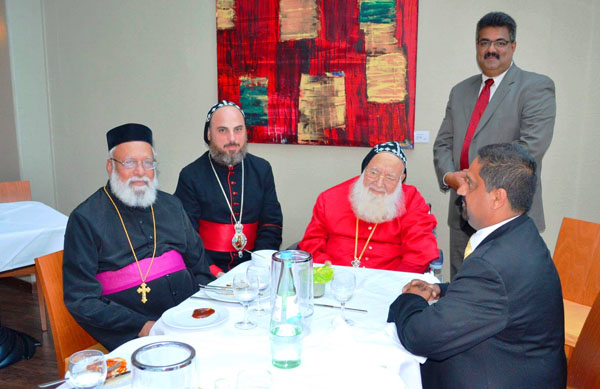 |
||
|
by George Mathew |
||
|
by HG Naheero Dr. Thomas Mor Themotheos 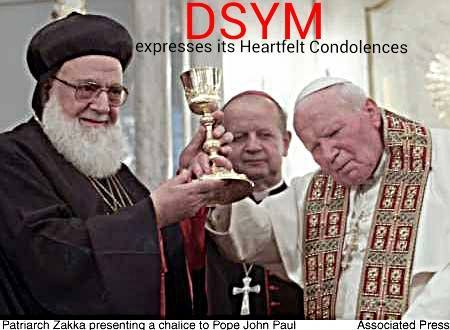 The formation of a joint theological commission between the Roman Catholic
Church and the Malankara Jacobite Syrian Orthodox Church was done through
explicit permission of H.H. the Pope and our Patriarch His Holiness Ignatius
Zakka I. This commission has achieved certain important understanding through
the annual dialogues which are held in Kerala. Both churches have come to a
consensus in the code of conduct regarding marriages that take place, when the
partners are from the two churches. In the modern global situation
interconfessional marriages do take place and it is only practical that a common
understanding is made. This is cited as a step forward in the ecumenical journey
of the churches whereby the day-to-day problems of the faithful members could be
resolved through proper dialogical understanding. This practical arrangement has
worked out well in Kerala and among the diaspora of Syrian Christians both
Catholic and Jacobite. Also, through the efforts of the commission, the churches
co-operate in the social witness and the theological formation of the clergy. In
the Dioceses and Archdioceses of both Jacobites and Roman Catholics in Kerala,
now there are closer co-operation in the various counseling programs and the
formation of the laity for evangelism and mission. These forward steps are the
direct and indirect outcomes of the efforts of the joint commission. His
Holiness Mor Ignatius Zakka I through the timely advice and common declaration
with H.H. Pope positively effected these changes.
The Middle East Council of Churches is an organization through which the
churches of the Middle East meet for theological reflection and joint action for
the President of this council has made many outstanding contributions. In the
fluid Middle East political scenario, the Christian churches have a great
challenge. The common witness to the wider society and the relationship to the
various types of regions demand unified approach from churches of different
traditions like the Syrian Orthodox, Coptic, Armenian, Roman Catholic,
Protestant, Eastern Orthodox, and several others. We could hope that the present
Iraq war and several other problems like Israel and Palestine issue would find
fair solutions and that the churches in this areas would play a greater
constructive role for the emergence of a free and democratic society.
d) Bilateral Dialogues
The multi-lateral and bi-lateral dialogues between the different traditions are
important aspects in the modern ecumenical relationships. The dialogue between
the Oriental Orthodox churches and the Reformed churches is such a one. Reformed
churches are a confessional group separated from the Roman Catholic Church
during the sixteenth century through the efforts of Calvin and Zwingli. These
churches have a global alliance and they are engaging in dialogue with Oriental
Orthodox churches in order to find out the commonalities and the differences in
faith. This dialogues are important because many oriental churches are to be
found in countries like Holland and Switzerland. The dialogue with Reformed
churches also is through the guidance of His Holiness. The cordial and sisterly
relationship between churches is an important aspect in the globalised modern
situation.
The Anglican-Oriental Orthodox dialogue is another bi-lateral dialogue. The
Anglican communion spread throughout the world has diverse dialogical
relationships with various other church traditions. There is an ongoing dialogue
between the Oriental Orthodox and Anglican traditions. The good results of these
dialogues would be beneficial for the Malankara church and the other Indian
churches like the Church of South India and Church of North India, because these
two latter churches (CSI & CNI) have emerged mainly from the Anglican tradition
in India, because of the 200 years of British rule.
e) Conclusion
As the supreme head of the Syrian Orthodox church, His Holiness Ignatius Zakka I
Iwas has done a great service to the promotion of dialogues with other church
traditions and between the Greek Orthodox and the Syrian Orthodox church, a
special relationship has developed in recent times. The Antiochean wing of the
Byzantine church and the Syrian Orthodox church have achieved a very cordial
relationship in places like Syria and Lebanon. There are many bi-lateral
agreements signed as a result of the mutual understanding. Several students and
monks of our church are trained at the theological faculties of Greece. His
Holiness the Patriarch made an ecumenical journey to Moscow during the
celebration of one thousand years of existence of the Russian Orthodox church.
Also must be mentioned the visit to the head quarters of the Armenian Orthodox
church.
His Holiness receives many heads of churches and church delegations in Damascus.
The present Pope visited the Syrian Patriarchate a couple of years back. The
Patriarch and Pope of Alexandria Shenouda III visited the Syrian Patriarchate.
The visit of the Armenian Cilician Catholicos to Damascus also deserves mention.
Several international meetings are taking place at the new Patriarchate,
Saydnaya, Damascus, now a days. All this has been possible through the great
vision of the Patriarch. I am indebted to His Holiness in a personal way for
deputing me to the Vienna consultations and to the recent international Joint
commission of the Oriental Orthodox and the Roman Catholic churches.
Source: The Fetschrift in Honor of His Holiness Ignatius Zakka I Iwas,
The formation of a joint theological commission between the Roman Catholic
Church and the Malankara Jacobite Syrian Orthodox Church was done through
explicit permission of H.H. the Pope and our Patriarch His Holiness Ignatius
Zakka I. This commission has achieved certain important understanding through
the annual dialogues which are held in Kerala. Both churches have come to a
consensus in the code of conduct regarding marriages that take place, when the
partners are from the two churches. In the modern global situation
interconfessional marriages do take place and it is only practical that a common
understanding is made. This is cited as a step forward in the ecumenical journey
of the churches whereby the day-to-day problems of the faithful members could be
resolved through proper dialogical understanding. This practical arrangement has
worked out well in Kerala and among the diaspora of Syrian Christians both
Catholic and Jacobite. Also, through the efforts of the commission, the churches
co-operate in the social witness and the theological formation of the clergy. In
the Dioceses and Archdioceses of both Jacobites and Roman Catholics in Kerala,
now there are closer co-operation in the various counseling programs and the
formation of the laity for evangelism and mission. These forward steps are the
direct and indirect outcomes of the efforts of the joint commission. His
Holiness Mor Ignatius Zakka I through the timely advice and common declaration
with H.H. Pope positively effected these changes.
The Middle East Council of Churches is an organization through which the
churches of the Middle East meet for theological reflection and joint action for
the President of this council has made many outstanding contributions. In the
fluid Middle East political scenario, the Christian churches have a great
challenge. The common witness to the wider society and the relationship to the
various types of regions demand unified approach from churches of different
traditions like the Syrian Orthodox, Coptic, Armenian, Roman Catholic,
Protestant, Eastern Orthodox, and several others. We could hope that the present
Iraq war and several other problems like Israel and Palestine issue would find
fair solutions and that the churches in this areas would play a greater
constructive role for the emergence of a free and democratic society.
d) Bilateral Dialogues
The multi-lateral and bi-lateral dialogues between the different traditions are
important aspects in the modern ecumenical relationships. The dialogue between
the Oriental Orthodox churches and the Reformed churches is such a one. Reformed
churches are a confessional group separated from the Roman Catholic Church
during the sixteenth century through the efforts of Calvin and Zwingli. These
churches have a global alliance and they are engaging in dialogue with Oriental
Orthodox churches in order to find out the commonalities and the differences in
faith. This dialogues are important because many oriental churches are to be
found in countries like Holland and Switzerland. The dialogue with Reformed
churches also is through the guidance of His Holiness. The cordial and sisterly
relationship between churches is an important aspect in the globalised modern
situation.
The Anglican-Oriental Orthodox dialogue is another bi-lateral dialogue. The
Anglican communion spread throughout the world has diverse dialogical
relationships with various other church traditions. There is an ongoing dialogue
between the Oriental Orthodox and Anglican traditions. The good results of these
dialogues would be beneficial for the Malankara church and the other Indian
churches like the Church of South India and Church of North India, because these
two latter churches (CSI & CNI) have emerged mainly from the Anglican tradition
in India, because of the 200 years of British rule.
e) Conclusion
As the supreme head of the Syrian Orthodox church, His Holiness Ignatius Zakka I
Iwas has done a great service to the promotion of dialogues with other church
traditions and between the Greek Orthodox and the Syrian Orthodox church, a
special relationship has developed in recent times. The Antiochean wing of the
Byzantine church and the Syrian Orthodox church have achieved a very cordial
relationship in places like Syria and Lebanon. There are many bi-lateral
agreements signed as a result of the mutual understanding. Several students and
monks of our church are trained at the theological faculties of Greece. His
Holiness the Patriarch made an ecumenical journey to Moscow during the
celebration of one thousand years of existence of the Russian Orthodox church.
Also must be mentioned the visit to the head quarters of the Armenian Orthodox
church.
His Holiness receives many heads of churches and church delegations in Damascus.
The present Pope visited the Syrian Patriarchate a couple of years back. The
Patriarch and Pope of Alexandria Shenouda III visited the Syrian Patriarchate.
The visit of the Armenian Cilician Catholicos to Damascus also deserves mention.
Several international meetings are taking place at the new Patriarchate,
Saydnaya, Damascus, now a days. All this has been possible through the great
vision of the Patriarch. I am indebted to His Holiness in a personal way for
deputing me to the Vienna consultations and to the recent international Joint
commission of the Oriental Orthodox and the Roman Catholic churches.
Source: The Fetschrift in Honor of His Holiness Ignatius Zakka I Iwas, Sept 14, 2005, V. Rev. Dr. Kuriakose Moolayil Corepiscopos (editor) Used with Permission |
||
|
by Archbishop Emeritus Mar Powathil
[Editor's Note: Archbishop Mar Joseph Powathil is known for his in-depth knowledge of the ancient patrimony and East Syrian Liturgy of the Syro-Malabar Catholic Church and his strenuous efforts for its reformation and restoration of liturgy in accordance with the directives of Vatican II. This article was written in 2005. It contains important information of the key role played by the LL Patriarch Zakka I in the field of ecumenism and inter-church relations. The importance of the document is further enhanced by the fact that it is written by an important bishop of Catholic Church.]As we know, the Patriarchate of Antioch claims the greatest antiquity of all the Churches of Christendom after Jerusalem. It was in Antioch that for the first time the disciples of Christ were called 'Christians'. Acts of the Apostles confirms this claim (Acts 11:26). According to tradition, St. Peter established the See of Antioch, presiding over it prior to his departure to the Roman West. In this period, the important political centres and their bishops had authority over the neighbouring centres and their bishops. Antioch enjoyed this pre-eminence. The Patriarch of Antioch held ecclesiastical authority over all the territory between the Mediterranean Sea and the Persian Gulf, a jurisdiction confirmed by canon 6 of the Council of Nicea (325 AD). His Holiness, Patriarch Ignatius Zakka I Iwas, the present inheritant of the Holy Throne of Antioch is very well known for his leadership and commitment in the field of ecumenism and reconciliation between the Churches. The initiative of His Holiness, the Patriarch and of Pope John Paul II in Rome led to the removal of the mantle of misunderstanding about the Christological formula of the Council of Chalcedon. At the conclusion of the visit of the Patriarch to Rome in 1984, in the common declaration Pope and the Patriarch stated that the past schism "in no way affect or touch the substance of their faith" since the divisions arose from terminological misunderstandings. They also stated: "In our turn we confess that He became incarnate for us, taking to himself a real body with a rational soul. He shared our humanity in all things but sin. We confess that our Lord and our God, our Saviour and the King of all, Jesus Christ, is perfect God as to His divinity and perfect man as to His humanity. This union is real, perfect, without blending, or mingling, without confusion, without alteration, without division, without the least separation. He who is God eternal and invisible, became visible in the flesh and took the form of servant. In Him are united, in a real, perfect indivisible and inseparable way, divinity and humanity, and in Him all their properties are present and active." (1)This common declaration, in fact, opened the way to Christological agreements with the other Oriental Orthodox Churches like the Coptic Church, Malankara Orthodox Syrian Church, etc. Both the Patriarch and Pope John Paul II will be remembered forever for this agreement after more than fifteen centuries. The common declaration of Pope John Paul II and Patriarch Ignatius Zakka I Iwas, considered the two Churches so close that they could even envisage cooperation in pastoral care, including some sacramental sharing. The agreement states: "It is not rare, in fact, for our faithful to find access to a priest of their own Church materially or morally impossible. Anxious to meet their needs and with their spiritual benefit in mind, we authorise them in such cases to ask for the sacraments of penance, Eucharist, and anointing of the sick from lawful priests of either of our two sister Churches, when they need them." (2)It was a historical agreement in modern time when the Catholic Church and an Orthodox Church have agreed to allow some forms of sacramental sharing. The declaration foresaw cooperation in the formation and education of the clergy. "It would be a logical corollary of collaboration in pastoral care to cooperate in priestly formation and theological education. Bishops are encouraged to promote sharing of facilities for theological education where they judge it to be available" (3) Both heads of the Churches wished "to widen the horizon of their brotherhood and affirm herewith the terms of the deep spiritual communion which already unites them and the prelates, clergy, and faithful of both their Churches, to consolidate these ties of faith, hope and love, and to advance in finding a wholly common ecclecial life." (4) As a follow up to this agreement, a culture of mutual sharing of facilities for theological education, both for the clergy and for the laity, evolved in a special way in India. The declaration added significant new elements to the developing ecclesiological consensus between the two Churches. It is an expression of Eucharistic ecclesiology that places the Eucharist at the centre of its understanding of the Church. It states: "Sacramental life finds in the holy Eucharist its fulfillment and its summit, in such a way that it is through the Eucharist that the Church most profoundly realises and reveals its nature... The other Sacraments... are ordered to that celebration of the holy Eucharist which is the centre of sacramental life and the chief visible expression of ecclesial communion. This communion of Christians with each other and of local Churches united around their lawful Bishops is realised in the gathered community which confesses the same faith" (5)Patriarch Ignatus Zakka was a fraternal delegate to the Second Vatican Council representing the Syrian Orthodox Church. His contribution to the ecumenical movement, through the Pro Oriente Consultation as the official delegate of the Syrian Orthodox Church, and later as the Protector of Pro Oriente is always remembered. He is also very active in the World Council of Churches, where he is at present a President, and the Middle East Council of Churches where he was once the Chairman. His scholarship in Syriac literature and theology is also widely acknowledged and appreciated. While the Syrian Orthodox Church celebrates the Jubilee of the enthronement of their Father and Head, His Holiness, Patriarch Ignatus Zakka I Iwas, the other Syriac Churches thank God for him and join the bishops, priests and the People of God in praying for him. Footnotes/References: 1. Information Service 55 (1984) 62.Source: The Fetschrift in Honor of His Holiness Ignatius Zakka I Iwas, Sept 14, 2005, V. Rev. Dr. Kuriakose Moolayil Corepiscopos (editor) |
||
|
by Dr. Kuriakose Theophilose Metropolitan 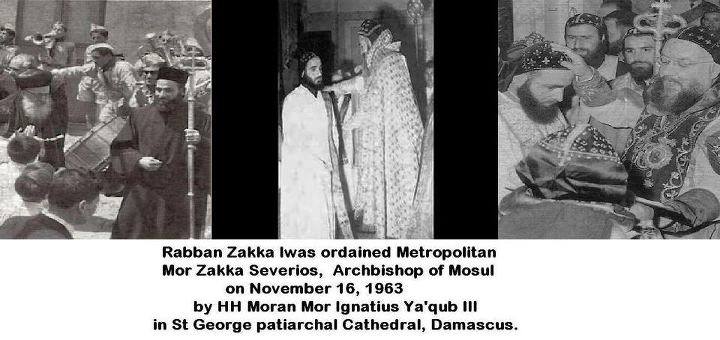 In the year 1960 he joined the General Theological College in New York and
studied oriental languages, philosophy and pastoral theology and mastered in
English language. In 1962 and 1963 he was delegated by the Patriarch to attend
the Second Vatican Ecumenical Council. In 1963 he was consecrated metropolitan
for Mosul. In 1969 he became the metropolitan of Baghdad where he served as the
head of the Syriac studies in the university and the member of the educational
academy. In the same year he was selected as the president of the Academy of
Iraq Culture. In the year 1978 he was appointed as the acting bishop of
Australia. On July 11, 1980, he was unanimously elected by the Holy Synod to the
throne of Patriarch of Antioch which was vacant after Patriarch Ignatius Yakoob
III's demise in 1980. On September 14, 1980, he was enthroned as the 122nd
Patriarch of Antioch and all the East, by name Ignatius Zakka I, in a rite
officiated by the late lamented Catholicos of the East, H.B. Baselius Paulose
II, along with the archbishops of the Universal Syrian Orthodox Church.
The Syrian Orthodox Church and the Patriarch of Antioch
The Christian Church has its roots in Jerusalem. Owing to many a persecution it
had to leave that place. Antioch, the capital of then Syria, was a cosmopolitan
city and became a refuge for the persecuted Christians. Slowly it became the
centre of Christianity. St. Peter, the chief of the Apostles of Jesus Christ,
first went to Antioch and established his throne in A.D. 37 and then left to
Rome. (This paved the way for the Syrian Orthodox Church and the Roman Catholic
Church to inherit the apostolic succession from the Petrine Throne). Antioch was
the centre of Christianity in Asia and in Antioch the followers of Christ were
first called Christians (Acts 11:26). The throne of St. Peter in Antioch was
succeeded by the Patriarchs of the Syrian Orthodox church and H.H. Ignatius
Zakka is the 122nd successor of Apostle Peter.
In the year 325, in the ecumenical council of Nicea, the whole Christian Church
was brought under the Patriarchate of Rome, Antioch and Alexandria and later in
the council of Constantinople the Patriarch of Constantinople was added. The
church in Syria, Persia and the east were under the jurisdiction of the
Patriarch of Antioch. The Syrian Orthodox Church has been scattered all over the
inhabited world. The universal Church thus seeks its unity in the Patriarch, the
supreme spiritual head.
Patriarch of Antioch and the Malankara Church
According to the tradition, apostle Thomas came to India in the first Christian
century and brought Christianity. But in the second and third centuries Indian
Christianity suffered a lot without proper leadership and clergy. In the 4th
century an immigrant group from Edessa, who were under the Patriarch of Antioch,
came to Kerala and the Thomas Christians came under the hierarchy of the
Patriarch of Antioch. The existence of the Church in India even during the 41,
century under the Patriarch of Antioch is beyond doubt. Between the 14th and 16"
century the Syrian Orthodox Church in India had to face some difficulties in
maintaining the contact with the Patriarch of Antioch because of some political
and colonial pressures in India. But overcoming the hurdles the church has been
blessed and guided by the hierarchy of the Patriarchs of Antioch.
A core issue arose after 1912 in the Syrian Orthodox Church in India when a
group in the Church started to question the role and the place of Patriarch in
the Syrian Orthodox Church in India. This group rebelled against the Patriarch
and claimed that the Syrian Orthodox Church in India is an autocephalous Church
and the Catholicose is equal to the Patriarch (In the church hierarchy Patriarch
is the supreme head and the Catholicose is next to him). The other group
retained the tradition of the Church affirming the supreme authority of the
Patriarch and the Church in India, a part of the Universal Syrian Orthodox
Church. This conflict was brought to the Supreme Court of India and in 1995 the
court declared that, "He (the patriarch) remains the supreme head of the Syrian
Church of which the Malankara Church is a division. He is spiritually supreme to
the Catholicose" (p.72. of the Supreme Court judgement 1995). Coming to an
agreement, protecting the interest of the Supreme Court, will be a way out from
the problem. Both factions follow the same liturgy, liturgical language,
tradition (even liturgical vestments) of the Syrian Orthodox Church.
The Patriarch Is the Symbol of Unity of the Syrian Orthodox Church
Church is an invisible spiritual communion of the saints. But it is also a
historical entity. The four characteristics of the church, one, holy, apostolic,
catholic should be realized historically too. In the Syrian Orthodox Church this
is happening through the Patriarch, who is the centre of unity.
H.H. Zakka I is a Pioneer of Ecumenism and Religious Tolerance
His love for his own Church and the love and respect to other Churches and
religions have helped him to open a new era of ecumenism and unity with other
religions. Ever since his enthronement, the Syrian Orthodox Church has its
active presence in ecumenical bodies. His ecumenical thirst may be the reason
that, even before becoming a bishop, he was sent by the Patriarch to represent
the Syrian Orthodox Church in the second Vatican council. In 1988, in the 7'
assembly of W.C.C. he was elected as one of the presidents of the W.C.C. It made
him follow ecumenism sowed by his predecessor. The agreements between the
Catholic Church and the Syrian Orthodox Church on eucharist and pastoral care
were milestones in the history of both Churches to bring unity. For the Church
in India the appointment of the Dialogue Commission between the Catholic Church
and the Syrian Orthodox Church and the outcome of the agreement on marriage
between the members of two churches signed by H.H. John Paul II and H.H.
Ignatius Zakka I are to be worthily mentioned. This commission continues its
task to bring unity among the churches and for common witness. His contributions
to the Vienna consultation, and initiative to protect the Middle East Council of
Churches shows his interest in this field. To make better unity with the
reformed churches he is active in the 'bi-lateral and multilateral'
consultations. The efforts of these discussions will bring forth fruits in
relationship of the Syrian Orthodox Church in India with the Church of South
India and the Church of North India.
His openness to other religions and cultures have helped him to identify the
rich religious and cultural heritage of India. During his first visit to India
he said "I come from a land where history was molded over the centuries. I come
from an area, which has been rightly described by historians as the cradle of
civilization. When I set foot in this country with its glorious history
extending over thousand of years, the great land which is another equally
notable cradle of human civilization, I am reminded of the essential oneness of
humanity... Tolerance of the Hindu religion helped the establishment of
Christianity in this country." In the religious pluralistic context of India his
attitude towards mission is significant. He continued, "The forceful conversion
is alien to the true culture and ethos of Christianity. I would even go to the
extent of saying that it is immoral for any religion to attempt forcible or
induced conversion. Christians in India should be able to attract their
non-Christian brothers and sisters by living an inspiring Christian life". His
Holiness is respected and honored in his country by the whole nation where 80%
of the population is Muslims.
A Messenger of Peace
His life is a witness for peace and harmony that he practises in his person and
in his relationship with other Churches and societies. One cannot forget his
ardent desire and sincere attempt to establish peace in the Malankara church.
In 1995 the honourable Supreme Court of India delivered a judgement modifying
the 1990 judgement of the Kerala High Court. The Supreme Court held that the
Malankara church is not an autocephalous (completely independent) Church, but
only a division (a part) of the Universal Syrian Orthodox Church, that the
Patriarch is the supreme head and spiritually superior to the Catholicos.
Immediately after the issuing of the judgement, His Holiness sent a general Bull
to the faithful in India expressing his desire to establish peace in the Church.
His Holiness wrote a second general Bull making some special suggestions on the
basis of the 1995 judgement so that the peace to be established would be on a
firm foundation. His Holiness also wrote directly to His Beatitude Basalius
Mathews II for establishing peace in accordance to the Supreme Court's decision.
Then H.H. sent his first secretary and the Patriarchal vicar for the Church
affairs in India to meet the Catholicos. But the attempts and appeals fell on
deaf ears. Then H.H. appointed a committee to have peace negotiations with the
other group. But before the negotiations finished, the other side violated the
mutual agreement and the peace talks collapsed.
At the instance of His Holiness the Coptic Patriarch and the Armenian Catholicos
wrote to His Beatitude Mathews II about establishing peace in the Church. He
interpreted the court judgement, "Malankara church is a division of the
Universal Syrian Orthodox Church", to mean that "the Malankara church is a
Church divided off from the Syrian Orthodox Church" That is, the Malankara
church is an independent church. (The supreme court had not held the Malankara
church to be divided off from the Syrian Orthodox Church, but a part of it). So
the peace attempts also failed. Then His Holiness directed the Church with him
to seek the mediation of the other local Church leaders, politicians and social
leaders unconditionally. Unfortunately the noncooperation of the other side left
the attempts without fruits. Even now His Holiness is in pain because of the
wound in the Indian church.
The Apostolic Visit to Malankara in 1982
H.H. Ignatius Zakka I had his first apostolic visit to India in 1982, two years
after his enthronement as the Patriarch of Antioch and all the East. He later
spent time in India beholding the prayers and praises of his spiritual children
in India. H.H. was received by the state Governments as their special guest and
was provided with all facilities. Irrespective of caste, creed and denomination,
large gathering assembled, where ever he visited. When he reached Kochi on the
7th February he was accorded a royal and loyal reception by a multitude,
numbering about 300,000, including ministers and high dignitaries. Warm
reception was showered on him by the Roman Catholic Church, The Mar Thoma Syrian
Church, The Church of South India, The Church of the East, The Independent
Church of Thozhiyoor and the Church of North India. It has to be recorded that
our Hindu and Muslim brothers and sisters also accorded him with a warm and
memorable welcome.
During his visit H.H. consecrated the "Holy Mooron" at the St. Mary's Church,
Manarcadu. He attended the 50th death anniversary of late lamented Patriarch
Ignatius Elias III at Manjanikkara. Another important event was the consecration
of a bishop at the Kothamangalam Mar Thoman Church (Cheriapally). In his visit
H.H. visited more than hundred parishes of the Syrian Orthodox Church in India.
In April 2000, H.H. once again visited India, to attend the Episcopal golden
jubilee of Mor Clemis Abraham, the late metropolitan of the Knanaya diocese of
the Syrian Orthodox Church.
The Apostolic Visit of His Holiness in 2004
His Holiness celebrates this year the silver jubilee of his enthronement as the
122nd successor of St. Peter. The Universal Syrian Orthodox Church celebrates
with the rigour of celebrates with rigour the blessed event throughout this
year. Two millions of its members live in India and His Holiness was very much
pleased to start the jubilee celebrations in India, the abode of tolerance,
universal love and brotherhood. The concluding event will be in 2005 at Damascus
in the presence of dignitaries from all over the world.
This holy visit was a new dawn in the history of the Church in India. On the
21st September 2004 all the adherents of church gathered at Cochin to celebrate
the patriarchal jubilee. The public meeting was adorned by the presence of
political, social, cultural and religious figures of the country.
Another significant event was the Jacobite Syrian Christian Association,
convened in the presence of His Holiness at Mulanthuruthy, as a continuation of
the famous "Mulanthuruthy Synod" of 1876. This was first time, after 1876, that
an association was convened in the presence of a Patriarch. The association of
1876 (called Mulanthuruthy Synod) was a land mark in the history of the Syrian
Orthodox Church in India. His Holiness Ignatius Pathrose III was present in that
association and His Holiness put an end to the monarchical and autocratic
administrative system in the Church and introduced a democratic set up in the
Church. Seven dioceses were formed and new bishops were consecrated to look
after them. Even today the Mulanthuruthy synod is the foundation for the present
administrative set up of the Syrian Orthodox Church in India (p.8085 of the
Supreme Court Judgement 1995). The 2005 Association, represented by the
delegates of the whole church affirmed the true apostolic succession of St.
Peter and the declared its loyalty and allegiance to the Holy Throne of St.
Peter and the Patriarch of Antioch and to the 2002 Constitution and reaffirmed
its faith. As the Supreme court of India said, the Syrian Orthodox Church in
India is an integral part of the Universal Syrian Orthodox Church and the
Patriarch of Antioch its supreme spiritual head. It was also declared that the
Catholicos faction, which claimed autocephaly and the throne of St. Thomas
excluded themselves from the mother church.
The consecration of the 'Holy Mooron' at the Mar Thoman Church, Kothamangalam,
was another high point in the Patriarchal visit. This was the fourth
consecration, in chronological order, of the Holy Mooron in the history of the
Jacobite Syrian Orthodox church in India. Earlier Patriarch Ignatius Peter III,
Ignatius Abdulla II and the present Patriarch H.H. Ignatus Zakka I had
consecrated the Holy Mooron in 1876, 1910 and in 1982 respectively at the
Mulanthuruthy Mor Thoman Jacobite Syrian Church and St. Mary's Jacobite Syrian
Orthodox Church, Manarcadu. Holy Mooron is normally consecrated by the head of
the Church, the Patriarch. In emergencies, the Catholicos of the East can also
do the same, with the permission of the Patriarch. The Holy Episcopal synod was
presided by H.H. during his visit and the Jubilee memorial centre, at Puthencruz,
was consecrated.
An Ardent Desire for Peace and Unity
The schism in the Syrian Orthodox Church in India is still an unhealed wound. It
is an aberrant in the Christian spirit of unity, love, peace and witness. It is
a burden for the society. The Patriarch is an embodiment of peace unity and
blessing. His Holiness ardently desired to solve the problem in the Church.
Since 1995 His Holiness and the Syrian Orthodox Church have been trying to solve
the problem and were ready for any amicable settlement on the basis of the
Supreme Court judgement. We have two options for a permanent unity and peace.
Either keeping the ecclesiology, tradition, theology of the Church and
preserving the Supreme court Judgement, let both parties be united by accepting
the Patriarch as the supreme head and the Syrian orthodox Church in India as an
integral part of the Universal Syrian Orthodox church or accept each other as
separate sister Churches, ceasing the enmity. It was our ardent desire that the
apostolic visit will be a boon for peace in the Church. It would have been the
best contribution that the Syrian church can give to the Church and society, if
the Catholicos faction freezes the suits filed against the Patriarch and the
Jacobite Syrian Church, which is the main obstacle for the unity of the church.
Unfortunately, instead of preparing an opportunity to sit together with the
supreme head of the Church, the Catholicos faction approached the court to
prevent His Holiness' Apostolic visit.
Let me recall the question of a journalist of the "Sunday" (4-10-1982):
Q. At the time when the Syrian Christian Community is so risen by factionalism,
does not Your Holiness think that the visit is ill timed? It could cause more
tension between the two sides?
A. "The purpose of my visit was to bring peace in the church for it grieves me
deeply to see a section of the community break away from the authority of this
ancient tradition. I had hoped that my visit would be a step in the right
direction... may be my message of peace will strike roots in the minds of the
people." His Holiness still prays and works for the peace in the Church. May His
Holiness' dream be fulfilled.
Conclusion
The Holy Father's visit granted new strength and spirit to the spiritual
children of the Syrian Orthodox Church in India and this land was blessed by the
presence of a holy man. After the Apostolic visit in Kerala His Holiness left to
New Delhi to bless his children and to meet the political leaders of India.
Showering apostolic blessings on his flocks, thanking the great land of India,
the successor of St. Peter left for Damascus.
Source: The Fetschrift in Honor of His Holiness Ignatius Zakka I Iwas,
In the year 1960 he joined the General Theological College in New York and
studied oriental languages, philosophy and pastoral theology and mastered in
English language. In 1962 and 1963 he was delegated by the Patriarch to attend
the Second Vatican Ecumenical Council. In 1963 he was consecrated metropolitan
for Mosul. In 1969 he became the metropolitan of Baghdad where he served as the
head of the Syriac studies in the university and the member of the educational
academy. In the same year he was selected as the president of the Academy of
Iraq Culture. In the year 1978 he was appointed as the acting bishop of
Australia. On July 11, 1980, he was unanimously elected by the Holy Synod to the
throne of Patriarch of Antioch which was vacant after Patriarch Ignatius Yakoob
III's demise in 1980. On September 14, 1980, he was enthroned as the 122nd
Patriarch of Antioch and all the East, by name Ignatius Zakka I, in a rite
officiated by the late lamented Catholicos of the East, H.B. Baselius Paulose
II, along with the archbishops of the Universal Syrian Orthodox Church.
The Syrian Orthodox Church and the Patriarch of Antioch
The Christian Church has its roots in Jerusalem. Owing to many a persecution it
had to leave that place. Antioch, the capital of then Syria, was a cosmopolitan
city and became a refuge for the persecuted Christians. Slowly it became the
centre of Christianity. St. Peter, the chief of the Apostles of Jesus Christ,
first went to Antioch and established his throne in A.D. 37 and then left to
Rome. (This paved the way for the Syrian Orthodox Church and the Roman Catholic
Church to inherit the apostolic succession from the Petrine Throne). Antioch was
the centre of Christianity in Asia and in Antioch the followers of Christ were
first called Christians (Acts 11:26). The throne of St. Peter in Antioch was
succeeded by the Patriarchs of the Syrian Orthodox church and H.H. Ignatius
Zakka is the 122nd successor of Apostle Peter.
In the year 325, in the ecumenical council of Nicea, the whole Christian Church
was brought under the Patriarchate of Rome, Antioch and Alexandria and later in
the council of Constantinople the Patriarch of Constantinople was added. The
church in Syria, Persia and the east were under the jurisdiction of the
Patriarch of Antioch. The Syrian Orthodox Church has been scattered all over the
inhabited world. The universal Church thus seeks its unity in the Patriarch, the
supreme spiritual head.
Patriarch of Antioch and the Malankara Church
According to the tradition, apostle Thomas came to India in the first Christian
century and brought Christianity. But in the second and third centuries Indian
Christianity suffered a lot without proper leadership and clergy. In the 4th
century an immigrant group from Edessa, who were under the Patriarch of Antioch,
came to Kerala and the Thomas Christians came under the hierarchy of the
Patriarch of Antioch. The existence of the Church in India even during the 41,
century under the Patriarch of Antioch is beyond doubt. Between the 14th and 16"
century the Syrian Orthodox Church in India had to face some difficulties in
maintaining the contact with the Patriarch of Antioch because of some political
and colonial pressures in India. But overcoming the hurdles the church has been
blessed and guided by the hierarchy of the Patriarchs of Antioch.
A core issue arose after 1912 in the Syrian Orthodox Church in India when a
group in the Church started to question the role and the place of Patriarch in
the Syrian Orthodox Church in India. This group rebelled against the Patriarch
and claimed that the Syrian Orthodox Church in India is an autocephalous Church
and the Catholicose is equal to the Patriarch (In the church hierarchy Patriarch
is the supreme head and the Catholicose is next to him). The other group
retained the tradition of the Church affirming the supreme authority of the
Patriarch and the Church in India, a part of the Universal Syrian Orthodox
Church. This conflict was brought to the Supreme Court of India and in 1995 the
court declared that, "He (the patriarch) remains the supreme head of the Syrian
Church of which the Malankara Church is a division. He is spiritually supreme to
the Catholicose" (p.72. of the Supreme Court judgement 1995). Coming to an
agreement, protecting the interest of the Supreme Court, will be a way out from
the problem. Both factions follow the same liturgy, liturgical language,
tradition (even liturgical vestments) of the Syrian Orthodox Church.
The Patriarch Is the Symbol of Unity of the Syrian Orthodox Church
Church is an invisible spiritual communion of the saints. But it is also a
historical entity. The four characteristics of the church, one, holy, apostolic,
catholic should be realized historically too. In the Syrian Orthodox Church this
is happening through the Patriarch, who is the centre of unity.
H.H. Zakka I is a Pioneer of Ecumenism and Religious Tolerance
His love for his own Church and the love and respect to other Churches and
religions have helped him to open a new era of ecumenism and unity with other
religions. Ever since his enthronement, the Syrian Orthodox Church has its
active presence in ecumenical bodies. His ecumenical thirst may be the reason
that, even before becoming a bishop, he was sent by the Patriarch to represent
the Syrian Orthodox Church in the second Vatican council. In 1988, in the 7'
assembly of W.C.C. he was elected as one of the presidents of the W.C.C. It made
him follow ecumenism sowed by his predecessor. The agreements between the
Catholic Church and the Syrian Orthodox Church on eucharist and pastoral care
were milestones in the history of both Churches to bring unity. For the Church
in India the appointment of the Dialogue Commission between the Catholic Church
and the Syrian Orthodox Church and the outcome of the agreement on marriage
between the members of two churches signed by H.H. John Paul II and H.H.
Ignatius Zakka I are to be worthily mentioned. This commission continues its
task to bring unity among the churches and for common witness. His contributions
to the Vienna consultation, and initiative to protect the Middle East Council of
Churches shows his interest in this field. To make better unity with the
reformed churches he is active in the 'bi-lateral and multilateral'
consultations. The efforts of these discussions will bring forth fruits in
relationship of the Syrian Orthodox Church in India with the Church of South
India and the Church of North India.
His openness to other religions and cultures have helped him to identify the
rich religious and cultural heritage of India. During his first visit to India
he said "I come from a land where history was molded over the centuries. I come
from an area, which has been rightly described by historians as the cradle of
civilization. When I set foot in this country with its glorious history
extending over thousand of years, the great land which is another equally
notable cradle of human civilization, I am reminded of the essential oneness of
humanity... Tolerance of the Hindu religion helped the establishment of
Christianity in this country." In the religious pluralistic context of India his
attitude towards mission is significant. He continued, "The forceful conversion
is alien to the true culture and ethos of Christianity. I would even go to the
extent of saying that it is immoral for any religion to attempt forcible or
induced conversion. Christians in India should be able to attract their
non-Christian brothers and sisters by living an inspiring Christian life". His
Holiness is respected and honored in his country by the whole nation where 80%
of the population is Muslims.
A Messenger of Peace
His life is a witness for peace and harmony that he practises in his person and
in his relationship with other Churches and societies. One cannot forget his
ardent desire and sincere attempt to establish peace in the Malankara church.
In 1995 the honourable Supreme Court of India delivered a judgement modifying
the 1990 judgement of the Kerala High Court. The Supreme Court held that the
Malankara church is not an autocephalous (completely independent) Church, but
only a division (a part) of the Universal Syrian Orthodox Church, that the
Patriarch is the supreme head and spiritually superior to the Catholicos.
Immediately after the issuing of the judgement, His Holiness sent a general Bull
to the faithful in India expressing his desire to establish peace in the Church.
His Holiness wrote a second general Bull making some special suggestions on the
basis of the 1995 judgement so that the peace to be established would be on a
firm foundation. His Holiness also wrote directly to His Beatitude Basalius
Mathews II for establishing peace in accordance to the Supreme Court's decision.
Then H.H. sent his first secretary and the Patriarchal vicar for the Church
affairs in India to meet the Catholicos. But the attempts and appeals fell on
deaf ears. Then H.H. appointed a committee to have peace negotiations with the
other group. But before the negotiations finished, the other side violated the
mutual agreement and the peace talks collapsed.
At the instance of His Holiness the Coptic Patriarch and the Armenian Catholicos
wrote to His Beatitude Mathews II about establishing peace in the Church. He
interpreted the court judgement, "Malankara church is a division of the
Universal Syrian Orthodox Church", to mean that "the Malankara church is a
Church divided off from the Syrian Orthodox Church" That is, the Malankara
church is an independent church. (The supreme court had not held the Malankara
church to be divided off from the Syrian Orthodox Church, but a part of it). So
the peace attempts also failed. Then His Holiness directed the Church with him
to seek the mediation of the other local Church leaders, politicians and social
leaders unconditionally. Unfortunately the noncooperation of the other side left
the attempts without fruits. Even now His Holiness is in pain because of the
wound in the Indian church.
The Apostolic Visit to Malankara in 1982
H.H. Ignatius Zakka I had his first apostolic visit to India in 1982, two years
after his enthronement as the Patriarch of Antioch and all the East. He later
spent time in India beholding the prayers and praises of his spiritual children
in India. H.H. was received by the state Governments as their special guest and
was provided with all facilities. Irrespective of caste, creed and denomination,
large gathering assembled, where ever he visited. When he reached Kochi on the
7th February he was accorded a royal and loyal reception by a multitude,
numbering about 300,000, including ministers and high dignitaries. Warm
reception was showered on him by the Roman Catholic Church, The Mar Thoma Syrian
Church, The Church of South India, The Church of the East, The Independent
Church of Thozhiyoor and the Church of North India. It has to be recorded that
our Hindu and Muslim brothers and sisters also accorded him with a warm and
memorable welcome.
During his visit H.H. consecrated the "Holy Mooron" at the St. Mary's Church,
Manarcadu. He attended the 50th death anniversary of late lamented Patriarch
Ignatius Elias III at Manjanikkara. Another important event was the consecration
of a bishop at the Kothamangalam Mar Thoman Church (Cheriapally). In his visit
H.H. visited more than hundred parishes of the Syrian Orthodox Church in India.
In April 2000, H.H. once again visited India, to attend the Episcopal golden
jubilee of Mor Clemis Abraham, the late metropolitan of the Knanaya diocese of
the Syrian Orthodox Church.
The Apostolic Visit of His Holiness in 2004
His Holiness celebrates this year the silver jubilee of his enthronement as the
122nd successor of St. Peter. The Universal Syrian Orthodox Church celebrates
with the rigour of celebrates with rigour the blessed event throughout this
year. Two millions of its members live in India and His Holiness was very much
pleased to start the jubilee celebrations in India, the abode of tolerance,
universal love and brotherhood. The concluding event will be in 2005 at Damascus
in the presence of dignitaries from all over the world.
This holy visit was a new dawn in the history of the Church in India. On the
21st September 2004 all the adherents of church gathered at Cochin to celebrate
the patriarchal jubilee. The public meeting was adorned by the presence of
political, social, cultural and religious figures of the country.
Another significant event was the Jacobite Syrian Christian Association,
convened in the presence of His Holiness at Mulanthuruthy, as a continuation of
the famous "Mulanthuruthy Synod" of 1876. This was first time, after 1876, that
an association was convened in the presence of a Patriarch. The association of
1876 (called Mulanthuruthy Synod) was a land mark in the history of the Syrian
Orthodox Church in India. His Holiness Ignatius Pathrose III was present in that
association and His Holiness put an end to the monarchical and autocratic
administrative system in the Church and introduced a democratic set up in the
Church. Seven dioceses were formed and new bishops were consecrated to look
after them. Even today the Mulanthuruthy synod is the foundation for the present
administrative set up of the Syrian Orthodox Church in India (p.8085 of the
Supreme Court Judgement 1995). The 2005 Association, represented by the
delegates of the whole church affirmed the true apostolic succession of St.
Peter and the declared its loyalty and allegiance to the Holy Throne of St.
Peter and the Patriarch of Antioch and to the 2002 Constitution and reaffirmed
its faith. As the Supreme court of India said, the Syrian Orthodox Church in
India is an integral part of the Universal Syrian Orthodox Church and the
Patriarch of Antioch its supreme spiritual head. It was also declared that the
Catholicos faction, which claimed autocephaly and the throne of St. Thomas
excluded themselves from the mother church.
The consecration of the 'Holy Mooron' at the Mar Thoman Church, Kothamangalam,
was another high point in the Patriarchal visit. This was the fourth
consecration, in chronological order, of the Holy Mooron in the history of the
Jacobite Syrian Orthodox church in India. Earlier Patriarch Ignatius Peter III,
Ignatius Abdulla II and the present Patriarch H.H. Ignatus Zakka I had
consecrated the Holy Mooron in 1876, 1910 and in 1982 respectively at the
Mulanthuruthy Mor Thoman Jacobite Syrian Church and St. Mary's Jacobite Syrian
Orthodox Church, Manarcadu. Holy Mooron is normally consecrated by the head of
the Church, the Patriarch. In emergencies, the Catholicos of the East can also
do the same, with the permission of the Patriarch. The Holy Episcopal synod was
presided by H.H. during his visit and the Jubilee memorial centre, at Puthencruz,
was consecrated.
An Ardent Desire for Peace and Unity
The schism in the Syrian Orthodox Church in India is still an unhealed wound. It
is an aberrant in the Christian spirit of unity, love, peace and witness. It is
a burden for the society. The Patriarch is an embodiment of peace unity and
blessing. His Holiness ardently desired to solve the problem in the Church.
Since 1995 His Holiness and the Syrian Orthodox Church have been trying to solve
the problem and were ready for any amicable settlement on the basis of the
Supreme Court judgement. We have two options for a permanent unity and peace.
Either keeping the ecclesiology, tradition, theology of the Church and
preserving the Supreme court Judgement, let both parties be united by accepting
the Patriarch as the supreme head and the Syrian orthodox Church in India as an
integral part of the Universal Syrian Orthodox church or accept each other as
separate sister Churches, ceasing the enmity. It was our ardent desire that the
apostolic visit will be a boon for peace in the Church. It would have been the
best contribution that the Syrian church can give to the Church and society, if
the Catholicos faction freezes the suits filed against the Patriarch and the
Jacobite Syrian Church, which is the main obstacle for the unity of the church.
Unfortunately, instead of preparing an opportunity to sit together with the
supreme head of the Church, the Catholicos faction approached the court to
prevent His Holiness' Apostolic visit.
Let me recall the question of a journalist of the "Sunday" (4-10-1982):
Q. At the time when the Syrian Christian Community is so risen by factionalism,
does not Your Holiness think that the visit is ill timed? It could cause more
tension between the two sides?
A. "The purpose of my visit was to bring peace in the church for it grieves me
deeply to see a section of the community break away from the authority of this
ancient tradition. I had hoped that my visit would be a step in the right
direction... may be my message of peace will strike roots in the minds of the
people." His Holiness still prays and works for the peace in the Church. May His
Holiness' dream be fulfilled.
Conclusion
The Holy Father's visit granted new strength and spirit to the spiritual
children of the Syrian Orthodox Church in India and this land was blessed by the
presence of a holy man. After the Apostolic visit in Kerala His Holiness left to
New Delhi to bless his children and to meet the political leaders of India.
Showering apostolic blessings on his flocks, thanking the great land of India,
the successor of St. Peter left for Damascus.
Source: The Fetschrift in Honor of His Holiness Ignatius Zakka I Iwas, Sept 14, 2005, V. Rev. Dr. Kuriakose Moolayil Corepiscopos (editor) |
||
|
The third Apostolic Visit of His Holiness Moran Mor Ignatius Zakka I Iwas, The
Patriarch of the Antioch & all the East to Kerala and India (Sept 20-30, 2004) truly made history
and will be preserved in the annals of the history of church. So, here is a
recap of that historic event.
KOCHI-INDIA, Sep. 20: His Holiness the Patriarch of the Antioch and all the East
Mar Ignatius Zakka-I Iywas arrived here on Monday on a seven-day visit to
Kerala.
Amid high security, thousands of devotees thronged the international airport at Nedumbassery to accord a tumultuous welcome to the supreme head of the Universal
Syrian Orthodox Church. Minister of Sate Mr. Dominic Presentation received the
visiting dignitary on behalf of the state government.
Catholicos Baselios Thomas I and other bishops of the Jacobite Syrian Church
received the religious head and the bishops accompanying him.
Patriarchal Assistant to Malankara Mor Julius Kuriakose, Synod secretary Mor
Gregorios Joseph, Mor Philoxenos Yuhanon, Mor Thimotheos Thomas, Mor Ivanios
Mathews, Mor Theophilos Kuriakose, Mor Miltheos Yuhanon, Mor Polycarpus
Geevarghese, Mor Athanasius Geevarghese, Mor Dioscorus Kuriakose, Mor Dionysius
Geevarghese, the Church Priest Trustee and Malankara Malpan Very Rev Kurien
Corepiscopa Kaniamparambil, lay trusty George Mathew Thekkethalackal, Secretary
Thambu George Thukalan, Rambans, Priests, Sisters and a large number of faithful
came to welcome the supreme pontiff of the Holy Church.
Apart from the Minister of State, the Member of Parliament Lonappan Nambadan,
U.D.F convener P.P. Thankachan, Members of Legislative Assembly, T.M. Jacob,
Saju Paul, V.J Paulose, K. Babu, P.J Joy, T.H Mustafa, M.A Chandrasekharan and
many other public dignitaries were also present at the Airport to receive His
Holiness.
Though tired after a long journey, His Holiness Zakka greeted the people at the
airport and extended blessings to the people of Kerala.
The Patriarch arrived by an Emirates flight from Damascus via Dubai to attend a
host of religious and public functions during his third visit to the Malankara
Church. H.H is accompanied by 12 member delegation, including Mor Athanasius
Elia Bahi (Patriarchal Assistant), Mor Silvanos Pathros (Homs), Mor Militius
Malki (Australia) and the Principal of St. Ephrem theological Seminary,
Damascus.
He will be accorded a public reception at Ernakulam on Tuesday marking the
beginning of yearlong silver jubilee celebrations of his enthronement as the
122nd successor to St Peter. The Patriarch, later, proceeded to a hotel in
Ernakulam. He will have no major functions on Monday, church sources said.
Apart from the Episcopal Synod of the Church at Karingachira on September 23,
the Patriarch will also attend the convention of Jacobite Syrian Christian
Association at Mulanthuruthy on September 27, seen as a major event, as a
visiting Patriarch is attending the meeting for the first time since 1876.
Tight security had been thrown in and around the airport for the Patriarch who
arrived here as the State Guest.
The Patriarch addresses press conference
KOCHI, Sep. 20: The Patriarch of Antioch, Mor Ignatius Zakka I, said here on
Monday that Jacobites are ready to hold talks with the Malankara Orthodox Church
on the basis of the 1995 Supreme Court verdict to foster ties with the two
Churches.
The Patriarch told mediapersons that Jacobites did not want to fight but wanted
to live in peace. "We want all the members of the Malankara Syrian Church to
come together and hold discussions to have peace, which is not practical in the
present circumstances'.
To a question on the possible tie-up with the Malankara Orthodox faction, his
response was: "How can they come to me when they have filed a case against my
visit to prevent me from seeing the people of Kerala. India is a great nation
and it would not deny permission to the head of the Church to see his people."
Elaborating on his moves to bring about a settlement, the Patriarch said: "The
initiative to end the dispute was taken several times by the Jacobite faction
and we waited for seven years before anointing Catholicos Baselios Thomas I as
the head of the Jacobite Church."
The Jacobites, even in these circumstances, were ready for discussions on the
basis of the 1995 Supreme Court verdict, he added.
When asked about the Church's stand if metropolitans who left the Jacobite
Church after the Supreme Court verdict were willing to come back, the Patriarch
said if such a thing happened, the Church would discuss it.
Referring to the activities of the World Ecumenical Movement, he said that the
movement does not have any powers and it could only give advice on issues. The
Patriarch is one of the presidents of the World Council of Churches.
About the role of Christians in India, he said India is a democratic country and
Christians have their own role to play and that they should be proud of their
nation. Asked about religious conversions snowballing into political issues, he
said the Syrian Church did not have such a practice.
Joseph Mar Gregorios, the Synod Secretary and Kochi diocese Metropolitan, said
"both the Kerala High Court and the Supreme Court have accepted our stand. We
have a rightful claim to carry on the age-old Syrian tradition. The other
Orthodox faction claims to be part of the Church, but resorts to one litigation
after the other and take over (individual) churches. We can accept them on the
basis of ecumenism, since we do not want any more cases". He also added that the
Government should come out with a formula to end the dispute over some of the
churches in Kerala. The Government can take over the property of the disputed
churches even while allowing believers to worship in these churches, he added.
(The Indian Express)
Silver Jubilee of H.H. Patriarch's enthronement begins
About 2,00,000 people attended the jubilee inauguration
KOCHI, INDIA, Sep. 21: The grand celebrations marking the silver jubilee year of
the enthronement of the Patriarch of Antioch, Moran Mor Ignatius Zakka I, began
in Kochi today at 5.00 pm. About 2,00,000 people participated in the marvelous
function held at the (late) Mor Baselios Paulose II Catholicos Nagar in Marine
drive ground, Cochin. 50,000 chairs with two large screens and many
closed-circuit TV's were arranged at the venue. The pandal itself was 1.5 lakh
sq.ft. which is the largest erected temporary structure in the place. The Marine
drive ground and the nearby city roads were overflowing with the faithful who
came from all over the state. Even three hours before the meeting had started,
the seats were full. As the Marine drive ground became insufficient to
accommodate all, the faithful had to spill over to the nearby city roads as
well.
At 5.00 pm His Holiness accompanied by the Catholicos Mor Baselios Thomas I came
to the venue in an open Jeep. It passed through the specially arranged path in
the centre of the ground. The over joyous crowd waved at His Holiness. The
Patriarchal flags were seen everywhere. People were shouting Long Live
Patriarch, Long Live Catholicos, Long Live Antioch-Malankara link !! The Police
officers and organizers found it very difficult to control the people as they
were so enthusiastic to come near the Patriarch. It was one of the biggest crowd
the city has seen for many years.
The public meeting started soon after His Holiness reached the dais. The
function which was presided by the Catholicos Aboon Mor Baselios Thomas I,
started with the welcome address by the Holy Episcopal Synod President Mor
Gregorios Joseph followed by the presidential address of His Beatitude the
Catholicos.
At 5.30 pm the Chief Minister of Kerala Mr. Oommen Chandy inaugurated the silver
jubilee celebrations of the enthronement of Moran Mor Ignatius Zakka I Iywas to
the Holy Apostolic throne of St Peter, the Patriarchate of Antioch and all the
East. Speaking on the occasion, Chandy applauded His Holiness the Patriarch for
his great contribution in the Christian Ecumenical world. He hoped that the
Patriarch's visit would bring prosperity to the Church and the Nation. Chandy
also tried to bring into the attention that Kerala was a role model for other
states with regard to religious amity.
Delivering the keynote address, Cardinal Mar Varkey Vithayathil, the head of the
Syro-Malabar Church in India stressed the role of Antioch and the Patriarchs in
Church history. He also recalled the warm relations existing between Rome and
Antioch. The bilateral agreement signed between Rome and Antioch in 1984 was a
milestone in Church unity. The relations between Rome and Antioch were so warm
that Rome invited Mor Ignatius Zakka (when he was only the Metropolitan in
charge of Mosul diocese) as an observer in the Second Vatican council, the
Cardinal said. The Cardinal also recalled the visit of the Patriarch Ignatius
Zakka I Iwas to Rome in 1984 and the Pope John Paul II's visit to the Patriarch
at Damascus in 2001.
Mar Thoma Church supreme head Philippose Mar Chrisostem said that "Correction in
the historic process is inevitable for all social movements.'' He wanted the
Church leadership to make the silver jubilee celebrations of the enthronement of
the Patriarch an occasion to recover humanity's love and righteousness. Mar
Chrisostem hoped that the Patriarch's Kerala visit would accentuate the ongoing
ecumenical movement in India.
Former Church of South India Moderator Bishop K J Samuel also spoke. He hoped
that the Kerala visit of the Patriarch would be an impetus to the ecumenical
movements in the country.
The veteran communist and leader of the opposition front in the Kerala Assembly
V.S Achuthanandan, Union Minister of State for Power P.M. Sayed, former Union
Ministers O. Rajagopal and P C Thomas, Ministers of State P K Kunjalikutty and
Dominic Presentation, UDF Convener P P Thankachen, former State Ministers T M
Jacob and K V Thomas, SNDP Yogam general secretary Vellappalli Natesan, Member
of Parliament Sebastian Paul, Press Trust Chairman Philip Mathew were among
others who spoke. Various other Religious and socio-political heads were also
present during the function.
The Patriarch in the end, addressing the mammoth gathering, said the
relationship with the Syrian Orthodox Church in India and the Patriarchate of
Antioch started in the early Christian century and was conformed in the council
of Nicea in AD 325. 'We are glad to note that this ancient tradition is still
kept alive. (Indian Express, The Hindu)
According to press reports this was the biggest crowd assembled at cochin in the
near past. The meeting concluded at 8.15 pm.
Patriarchal address at the public meeting in Cochin
(September 21, 2004) We are extremely delighted to be here this evening with you
all. It is always a great joy to visit India, the great nation of sages and
saints, this beautiful state Kerala, "Gods own country", and particularly our
church here in India.
We remember with much gratitude, the warm reception we received from the general
public, the previous times we visited India. We still cherish the fond memories
of those visits. We wish to once again thank the honourable governments, both at
the centre and here in Kerala for their kind hospitality. We are happy that the
same spirit has been shown to us even this time.
When we see this great crowd here, we marvel at the love that you show to the
Holy throne of Antioch. We can only talk about our church in India with mixed
feelings. On the one hand, we are extremely happy to see the progress our church
has made under the efficient leadership of our spiritual brother in Christ His
Beatitude Baselios Thomas 1st, the Catholicos and Metropolitan Trustee. His
Beatitude is a born leader. God has bestowed many good qualities upon him. In
times of crises he will never waiver. His loyalty to the Holy throne of Antioch
is unflinching. He will never compromise aspects of true faith and traditions.
He will always walk ahead and with his people. In His Beatitude you have a great
leader whom you can always trust and look upon. He will stay like a rock when it
comes to matters of faith. We remember with gratitude the great sacrifices of
Late Lamented His Beatitude Mor Baselios Paulose IInd along with the late
Lamented Mor Gregorios Geevarghese made for this church. We want to appreciate
the leadership of His Beatitude Baselios Thomas Ist at this time and thank him
for the same. May God grand him good health and long life. We also would like to
acknowledge the services of all our Archbishops who stood with His Beatitude and
the faithful, especially during the time of crisis. We urge all of you to
continue to extend your prayerful support to His Beatitude Baselios Thomas Ist
and to the Holy Episcopal Synod.
Christianity in India is as old as the beginning of the Christian Church. India
had the great fortune of having received the gospel of Christ in the first
century itself through Apostle St. Thomas. The relationship with the Syrian
Orthodox Church in India and the Patriarchate of Antioch started in the first
Christian century, was confirmed in the council of Nicea in AD 325. We are glad
to note that this ancient tradition is still kept alive. While we rejoice in
this, as the spiritual head of the church, we are equally saddened that a group
has gone astride from the mother church.
Unfortunately, this rift has lead to many court cases in India, which has become
a disgrace to the entire Christian community in India. As the Supreme head of
the church, we have always stood for making peace in the church. In fact, the
1995 verdict of the Honourable Supreme Court of India provided us with an
excellent opportunity for peace and unity in the both fractions here. However,
we missed the opportunity because the other faction was not willing to accept
the challenge. We tried our level best to make an amicable settlement on the
basis of the honourable Supreme Court Judgment and waited seven years for unity
and peace in the church. That was not to be. It was in this context and on the
request of our faithful here that we decided to consecrate His Beatitude
Baselios Thomas Ist as the Catholicos of our church here. Today when I see this
crowd, I am more than convinced that we made a correct decision and a correct
choice. May our church continue to prosper under the spiritual leadership of
His Beatitude Baselios Thomas Ist and our Holy Episcopal Synod in India.
At this time, we also would like to appreciate the Government of Kerala of its
positive role and approach in our church affairs. The state government knew that
our cause was just. We wish to record our gratitude and thanks for the
Honourable Government for their care. Our particular thanks to the former Chief
Ministers Mr. K. Karunakaran, late Mr. E.K. Nayanar, Mr. A.K. Antony and his
council of ministers and his successor Mr. Oommen Chandy for their constant
support and cooperation. Our sister churches and their leaders also expressed
their concerns and extended their help in hands for reconciliation through
mediation. Also the contributions of the cultural leaders of Kerala are worthy
to be mentioned.
Once again we are so glad we could come to India, which is the largest democracy
in the world. You have yet again proved through the recent elections that the
roots of democracy here are, indeed, strong. Everyone can be proud of these
traditions of democracy and secularism in India. We remember with great respect
Mahatma Gandhi, the father of the Nation. This land is the cradle of the rich
and ancient culture and civilization. Kerala has been home to people of all
faiths and nationalities. When religious fundamentalism and conflicts are
destroying nations, Kerala has stood as a model for all nations to learn from.
Here, people of all religion live in harmony. We have experienced this during
all our visits to India. Minority religions such as Christianity have received
royal patronage from the Hindu rulers in the past. Our own church, the Syrian
Orthodox Church, has been a beneficiary of this generous attitude of Hindu
brothers and sisters. Our Syrian community, in turn has accommodated many
aspects of Hindu culture in their social and religious life. We are happy to
note that our church has been able to maintain a cordial relationship with all
religions here. It is our responsibility to be faithful to our own religious
traditions and to be open to others and to respect the faith of the brothers and
sisters of other religious traditions. We urge to continue this spirit of
cooperation and to take a stronger role in nation building. The church is the
extension of God's incarnation in Jesus Christ. Our mission in India is to
share the immense joy of Gospel, not forceful conversion. Gospel is to be shared
not to be imposed and our challenge is to witness the love of God through our
lives. It is our calling to be the voice of the voiceless, the poor and
marginalized. We should never entertain a minority complex; rather we should
continue to be part and parcel of the national life in India.
We take this opportunity to thank you all for the preparation of the Patriarchal
Silver Jubilee celebrations of enthronement to the Holy Throne of St. Peter and
for the good words. Let me thank Oommen Chandy, the Chief Minister of Kerala and
his cabinet ministers for making my visit possible and all the facilities
provided as a state guest and for his personal presence here. I thank Cardinal
Varkey Vithayathil and all the leaders of the sister churches who were here and
the social, cultural and political dignitaries present here.
We expect that you all pray for us to continue our efforts to glorify our Lord
Jesus Christ through the years to come.
We wish you all the best and thank you. May God Bless you.
Kerala famous for religious amity: Chief Minister Oommen Chandy
Kochi: Kerala Chief Minister Oommen Chandy has said Kerala was famous for its
religious amity and has maintained the tradition of religious harmony
successfully. Addressing a mammoth public meeting after inaugurating the silver
jubilee celebrations of Patriarch of Antioch and all the East, Moran Mor
Ignatius Zakka Iwas, enthronement to the Holy Apostolic throne of St Peter,
Chandy said Kerala was a role model for other states with regard to religious
amity.
The Patriarch, in his address, said the relationship with the Syrian Orthodox
Church in India and the Patriarchate of Antioch which started in the first
Christian century was conformed in the council of Nicea in AD 325. 'We are glad
to note that this ancient tradition is still kept alive.
While we rejoice in this, as the supreme spiritual Head of the Church, we are
equally saddened that a group had gone astride from the mother church', he said
apparently referring to the orthodox faction of the Malankara church.
'Unfortunately, this rift had lead to many court cases in India, which has
become a disgrace to the entire Christian community in India', the Patriarch
said adding as the supreme head of the church, we have always stood for making
peace in the church.
Union Minister Ram Vilas Paswan visits His Holiness
KOCHI: Union Minister for Chemicals and Fertilisers Ram Vilas Paswan met the
Patriarch of Antioch and all the East, Ignatius Zakka Iwas, here on Tuesday.
Jacobite church sources described the visit as a "courtsey call." The head of
the Jacobite Syrian church in Kerala, Catholicos Baselious Thomas I was also
present.
Moran Mor Ignatius Zakka I Iwas, the supreme head of the Universal Orthodox
Syrian Church, reached here on Monday on a seven-day visit to Kerala. Paswan
later left for Thiruvalla. (Indian Express)
The Patriarch offers prayers at Mor Clemis' tomb
CHINGAVANAM, Sep. 22: Thousands of faithful thronged the St John's Dayara Church
on Wednesday to have a glimpse of Patriarch of Antioch, Ignatius Zakka I, as he
came to offer prayers at the tomb of the late Knanaya Jacobite Church
Metropolitan Abraham Mar Clemis.
After a rousing reception at the church in the morning, the Patriarch offered
'dhoopa prarthana' at the tomb. Knanaya Metropolitan Kuriakose Mar Sevarios
presided over the function.
Referring to the tirade against the visiting Patriarch by the Orthodox faction,
Catholicos Baselios Thomas I of the Jacobite Church felt that the reactions of
the opposite sect were borne out of an 'unsound state of mind.' He also charged
the rival faction with torpedoing peace efforts in the Malankara Church.
The Patriarch also addressed Knanaya Association members. His visit turned out
to be a joyous occasion for the Knanaya Jacobite Church since it was the first
after the consecration of Kuriakose Mar Sevarios as the new Metropolitan. The
Patriarch had been to the church in 2000 to participate in the golden jubilee
episcopacy fete of former Metropolitan Abraham Mar Clemis. The Patriarch left
for Manjanikkara by 4 p.m. to offer prayers at the tomb of the late Benyamin Mar
Osthathios. (The Indian Express)
Rousing reception to H.H. Patriarch at Manjanikkara
PATHANAMTHITTA, Sep. 22:
The head of the Universal Syrian Orthodox Church and
Patriarch of Antioch and all the East, Ignatius Zakka-I Iwas, was given a grand
reception at Manjanikkara Dayro when His Holiness came to pray at the tomb of
Patriarch St. Elias III and other Metropolitans entombed here. Thousands of
faithful were present there to receive His Holiness.
Speaking after the reception accorded to him by the Kollam, Niranom and
Thumpamon dioceses of the Church at Manjanikkara Mor Ignatius Dayara at Omallur,
the Patriarch said that the mission of his visit was to acknowledge the love
bestowed on him by the faithful. The Patriarch lauded the contribution of Mor
Yulios, Yakob Mor Yulios and Benyamin Mor Osthatheos.
The public meeting held at the Manjanikara school grounds was presided by the
Catholicos Mor Baselius Thomas-I. Metropolitans Mor Athanasius Elias Bahi of
Damascus, Pathrose Mor Silvanos of Homs and Malki Mor Milithios of Austria
accompanied the Patriarch to the venue.
The Metropolitans of the Church, Youhanon Mor Peelexinos, Kuriakose Mor Eulios,
Geevarghese Mor Athanaseus, Markose Mor Koorilos, Gevarghese Mor Divanasios,
were among the speakers.
Yuhannon Mor Milithios, Joseph Mor Gregorios, Mathews Mor Ivanios, Kuriakose Mor
Yulios, Geevarghese Mar Athanasius, Kuriakose Mor Diascorus, Kuriakose Mor
Theophilos and Kuriakose Mor Severius were also present at the meeting.
Earlier, the believers accorded a rousing reception to the Patriarch at the St.
George Jacobite Church in Thiruvalla. He was received at the Omalloor Cross
situated on the way to Dayro when he, escorted by a motorcade, reached there
around 5-30 p.m. Malankara Malpan Very Rev. Kurien Cor-Episcopa Kaniamparampil
garlanded the Patriarch and he was escorted to the Manjanikkara Dayro by the
Metropolitans, Markose Mar Koorilos and Youhanon Mar Militheos, later.
At Manjanikkara, the Patriarch was accorded a reception under the leadership of
Kuriakose Mor Yulios and Geevarghese Mor Dionysius. The Patriarch offered
prayers at the tombs of Mor Yulios, Yacob Mor Yulios and Benyamin Mor
Osthatheos. The Patriarch also said prayers at the nearby Mor Sthephanos Church.
(Indian Express, The Hindu).
The book titled 'The Syrian Orthodox Church Calendar' released by His Holiness
Manjanikkara, Sep. 22: His Holiness the Patriarch today released the book titled
"The Syrian Orthodox Church Calendar" by accepting the first copy from His
Beatitude the Catholicos at the public meeting held at Manjanikkara. This book
compiled and edited by Fr. (Dr.) Mani Rajan, contains the dates of feasts of the
saints, fasts and festivals of the Church, dates of movable feats for the 21st
century as per Julian and Gregorian Calendars and articles related to the origin
and evolution of the Church Calendar.
The main source of the saints list included in this book is the manuscript of
the Church Calendar revised by the monk-priest Saliba bar Khayrun of Hah
(+1340), which was made available to the publishers by His Eminence Mor Julius
Kuriakose Metropolitan, the first secretary to His Holiness the Patriarch. The
feast dates and the list of saints in this book has been updated as of today.
Total Pages 128 (English).
Copies are available in the book stalls at Manjanikkara Mor Ignathios Dayro,
Kottayam St. Joseph's Cathedral, M.S.O.T Seminary, Mulanthuruthy Marthoman
Church, Manarcaud KEFA Book Stall, MGOCSM Kottayam, Orthodox Book Centre
Kottayam.
Karingachira St. George Jacobite Syrian church declared Cathedral
KOCHI, Sep. 23: The Patriarch of Antioch & all the East and the Supreme head of
the Universal Syrian Orthodox Church Moran Mor Ignatius Zakka I declared the
ancient St George Jacobite Syrian church at Karingachira near Tripunithura as
the cathedral of Kochi diocese, as part of the historic Episcopal synod held
here on Thursday, 23rd September 2004. The church will henceforth be known as
'St. George Jacobite Syrian Orthodox Cathedral of Cochin Diocese'.
Established in AD 722, the St George church has witnessed several historic
events in the history of the Malankara Church. The late Geevarghese Mar
Gregorios Metropolitan, popularly known as 'Parumala Thirumeni' ascended the
first step of ordination at this church.
This is the parent worship place of many churches including Tripunithura Nadamel
Church, Kadungamangalam Church, Varikkoli Church, Kanyattu Nirappu Church,
Veloor Church and Vennikkulam Church. The chapels like Kakkadu, Ambalamugal and
Kureekkadu will also come under the control of Karingachira Church.
The church structure is a perfect blend of Persian and Indian traditional
architecture. This historic and religious place, which attracts thousands of
devotees irrespective of their caste, will be the first church in Kochi diocese
to be upgraded as a cathedral. (Indian Express)
The Holy Episcopal Synod of the Malankara Archdiocese presided by the Patriarch
of Antioch & all the East after many decades
KOCHI, Sep. 23: The Full-fledged Episcopal Synod of the Malankara Syrian
Jacobite Church, held after many decades in the presence of Patriarch of
Antioch, decided to broad base the activities of the Church across the country
with more focus on indigenisation.
The synod also decided to set up more dioceses, consecrate additional bishops
and translate the Church liturgy into various regional languages.
This was the first time in the recent history of the Malankara Church that the
Synod was meeting in the presence of the Patriarch.
The synod, held at St George Jacobite church at nearby Karingachira, was
attended by Catholicos Baselios Thomas I and 16 metropolitans, including three
Syrian Metropolitans who accompanied the H.H. the Patriarch on this Apostolic
Visit. Briefing reporters on the synod deliberations in the presence of the
Patriarch, synod secretary Joseph Mar Gregorios said that the Church would carry
out its expansion with special emphasis on indigenisation. "The Church is
already on the path of Indianisation. But we want to accelerate the pace,'' he
said.
Another major decision was the declaration of the St Mary's Church at Manarcaud
as a pilgrim centre of the Universal Syrian Church.
The synod also permitted the parishioners of St Thomas Jacobite Syrian Church,
North Paravur, and St George Church, Arthattu in Kunnamkulam to remember Mor
Gregorios Abdul Jaleel and Mor Osthathios Sleeba in the prayers. The names of
both the departed spiritual heads will henceforth be included in the 'Thubdeen'
(the episodes in the prayer which remembers the forefathers and the rich
heritage of the Malankara Church) of these churches where their tombs are
located.
Answering a query, Catholicos Baselius Thomas I said that the Jacobite Church's
ongoing tussle with the Malankara Orthodox Church did come up at the synod. "We
are ready for compromise talks. But before the talks, they should 'freeze' the
litigation and should cooperate with the Government for reopening the closed
churches, facilitating worship of the members belonging to both the factions.''
The Metropolitans who participated in the Karingachira Episcopal Synod are Mor
Philoxenos Yuhanon, Mor Polycarpus Geevarghese, Mor Thimotheos Thomas, Mor
Gregorios Joseph, Mor Yulius Kuriakose, Mor Koorilos Markose, Mor Ivanios
Mathews, Mor Dionysius Geevarghese, Mor Milithios Yuhanon, Mor Dioscorus
Kuriakose, Mor Athanasius Geevarghese, Mor Theophilos Kuriakose, Mor Severios
Kuriakose and the three Syrian Metropolitans Mor Athanasius Elia Bahi
(Patriarchal Assistant), Mor Silvanos Pathros (Homs), Mor Milithios Malki
(Australia).
The new Church Headquarters at Puthencuriz Consecrated
PUTHENCURIZ, Sep 24: His Holiness Ignatius Zakka I Iwas, the Patriarch of Antioch
& all the East, today consecrated the newly-built Patriarch Centre at
Puthencuriz which will hence forth function as the headquarters of the Jacobite
Syrian Church. The Catholicos H.B. Baselios Thomas I, Metropolitans, Samudaya
Secretary Thambu George Thukalan and Samudaya Trustee George Mathew
Thekkethalakkal were among those present at the function. The new centre
consists of a chapel, Committee halls, office rooms for all the office bearers
of the Church, central offices for the spiritual organizations of the Church,
Library and Archives, suites for the Bishops, guest rooms, dining hall etc.
Immediately after the consecration ceremony, the Church Managing committee was
held under the president ship of the Patriarch in which the Catholicos and all
the metropolitans were present. Addressing the committee members the Patriarch
said that he is very happy to see his brother in Christ, Catholicos Baselios
Thomas I, leading this church with a Godly mission. "There was a time when a
section within the Church had tried to mislead me saying that it was Catholicos
Baselius Thomas I who was standing in the way of bringing permanent peace in the
Church. Now, I am convinced that he was prepared for any sacrifice for unity.'',
the Patriarch continued. The Patriarch extended all support to the Catholicos
for leading the Church to prosperity. Afternoon, the Patriarch addressed the
representatives of the various Spiritual Organization at the Church HQ.
In the evening His Holiness visited the tomb of late lamented Catholicos of the
East Aboon Mor Baselios Paulose II at Malecuriz Dayro, situated only a few
distance away. (In 1980 it was Mor Baselios Paulose II Bava who led the
Patriarchal enthronement ceremony of H.H. Ignatius Zakka I.) The Patriarchal
bull appointing Mor Dioscoros Kuriakose as the Metropolitan of Dayro was read on
that occasion.
From Malecuriz, H.H. the Patriarch left for Mulanthuruthy Seminary where he met
the Seminary students and the faculty. The President of the seminary & the
Malabar Diocesan Metropolitan Mor Philoxenos Yuhanon, the Resident Metropolitan
Mor Theophilos Kuriakose, the Principal Very Rev. Adai Corepsicopo and others
received the Patriarch. Malankara Malpan Very Rev. Kurien Corepsicopo, the great
Syriac Scholar and the author of many books, despite his old age, was also
present at the Seminary to welcome the Patriarch.
Patriarch H.H. Ignatius Zakka I Iwas consecrated the Holy Myron at the Marthoma
Cheriapally
KOCHI, Sep. 25: In an atmosphere charged with prayers and hymns, the
consecration of myron (holy oil) was held at the ancient St Thomas Church
(Marthoma CheriaPally) at Kothamangalam on Saturday.
Tens of thousands of Jacobite Christians thronged the church premises to witness
the rare ritual.
Myron, the holy oil, is used to anoint persons receiving baptism by water. It
represents the Gifts of the Holy Spirit. The ritual, described as ''a great
mystery'' in theological circles and among the Fathers of Churches, was led by
Patriarch of Antioch Mar Ignatius Zakka I. The five-hour-long ritual was also a
proclamation by the Syrian Jacobite Church reaffirming its faith on the
tradition of Antioch.
The consecration of myron was held in two phases. In the first, the
'preparations' prior to the consecration was held. Recalling how John the
Baptist prepared the way for the coming of Jesus Christ, the deacons and the
priests took out a procession around the church.
The second procession consisted of deacons, priests, 12 metropolitans of the
Church and the high priest (the Patriarch) with the holy oil in his hand. The
second stage of the ritual was the sanctification of the holy oil by offering
special prayers. According to belief, the high priest, through his prayers, is
expected to bring in all the dynamism of the Holy Spirit to the oil.
After the sanctification of the holy oil, the Patriarch blessed the world by
spraying it in four directions. As a fulfillment of the sacrament, Holy Qurbana
by 13 celebrants was said at a specially set up madbaha on the church premises.
It is after an interval of 22 years that consecration of Holy Myron is held in
the Malankara Church. The ritual was last performed at Manarcaud St Mary's
church in 1982.
Catholicos Baselios Thomas I assisted the Patriarch in leading the ritual. Mor
Philoxenos Yuhanon, Mor Polycarpus Geevarghese, Mor Thimotheos Thomas, Mor
Gregorios Joseph, Mor Yulius Kuriakose, Mor Koorilos Markose, Mor Ivanios
Mathews, Mor Dionysius Geevarghese, Mor Milithios Yuhanon, Mor Dioscorus
Kuriakose, Mor Athanasius Geevarghese, Mor Theophilos Kuriakose, Mor Severios
Kuriakose and the three Syrian Metropolitans Mor Athanasius Elia Bahi
(Patriarchal Assistant), Mor Silvanos Pathros (Homs), Mor Milithios Malki
(Australia) are the metropolitans who participated in the consecration of Holy
Myron. (Indian Express)
St. Mary's Soonoro church at Cochin elevated as the Patriarchal Cathedral of
India
Mor Yulious Kuriakose appointed as the Metropolitan of all the Simhasana
Churches.
KOCHI, SEPT. 26: Moran Mor Ignatius Zakka I Iwas, the Patriarch of the Antioch
and all the East on Sunday declared the St. Mary's Soonoro Simhasana church at
Ernakulam as the first Patriarchal cathedral in India and also announced the
appointment of Kuriakose Mor Yulious, the first secretary of His Holiness, as
the Metropolitan of all the Simhasana Churches.
At a well-attended function on the church premises this evening, the Patriarch,
assisted by the Catholicos Baselios Thomas I and a host of other Church
dignitaries held prayers at the Soonoro church before it was declared a
cathedral at the public meeting.
The Patriarch triggered a bunch of blue and white balloons into the air with the
help of a remote control device to mark the occasion as the crowd of about 2,000
people waved yellow flags. The Patriarch said he was happy to declare the
Soonoro church a cathedral and appealed to the faithful to thank God for the
favour.
The Patriarch then inaugurated a new building in memory of the late Gregorios
Geevarghese, the founder of the Soonoro church. His Holiness also blessed the
foundation stone for the construction of the new Cathedral.
Catholicos Mor Baselios Thomas I, who presided over the function, hoped that the
construction of the new church would be completed soon. Besides the
Metropolitans, the Fisheries and Sports Minister Dominic Presentation, Former
Minister T.M. Jacob and 2000 odd parishioners participated in the function. (The
New Indian Express & The Hindu)
Cathedral status for the Manarcaud St. Mary's church
KOTTAYAM, Sep. 26: The Supreme Pontiff of the Universal Syrian Orthodox Church
H.H. Patriarch Moran Mor Ignatius Zakka I Iywas today elevated the St. Mary's
Church at Manarcad as a 'universal pilgrim centre' and also declared it as a
Cathedral amid chants of 'let Antioch-Malankara ties last for ever' by thousands
of church followers.
Speaking on the occasion His Holiness reminded that the Syrian Church attached
much importance to Virgin Mary and her intercession between God and believers.
The Patriarch said the Manarcaud St Mary's Church had become a great pilgrim
centre where thousands became blessed through prayers; and added that the
miracles performed by Virgin Mary here were uncountable.
The Patriarch also announced on the occasion that the steps to declare the late
Malankara Metropolitan Kochuparambil Paulose Mar Koorilos (Panampady, 1917), a
saint, had commenced. His Holiness was accompanied to the church by the
Catholicos Aboon Mor Baselios Thomas I, and Metropolitans.
The Patriarch call to shun abortion
The Patriarch during the sermon at the Manarcaud church came down heavily on
abortion saying it as a crime committed by men and women and cautioned the
faithful against the medical termination of pregnancy. Terming abortion a sin,
the Patriarch said the killing of unborn children was on the increase. He called
upon all those who have been party to medical termination of pregnancy to repent
and receive Eucharist as a means to cleanse themselves of the sin. The Patriarch
said the mothers had a duty of offering babies to the world and grooming them in
a good way and recalled that Virgin Mary was a role model for men and women.
(The New Indian Express & The Hindu)
The Jacobite Syrian Christian Association met at the Mulanthuruthy Marthoman
Church after 128 years under the presidentship of the Patriarch of Antioch & all
the East
MULANTHURUTHY, Sep. 27: After 128 years, the 'Jacobite Syrian Christian
Association', today met at the Mulanthuruthy Marthoman church premises for the
2nd time in its history under the presidentship of the Patriarch of Antioch and
all the East. It was at the same place the first Syrian Christian Association,
which is also known as the 'Mulanthuruthy Synod' that was held for 3 days from
June 27 -30, 1876, under the president ship of late Patriarch of Antioch Moran
Mor Ignatius Peter IV. The chief organizer of this historic Synod was Saint
Gregorios (Parumala Thirumeni) who was the personal secretary to H.H. Patriarch
Peter IV.
Now in 2004, it was another meeting of the 'Jacobite Syrian Christian
Association' that was held under the presidentship of the Prince Patriarch of
Antioch & all the East, Moran Mor Ignatius Zakka I Iywas. In this second
Mulanthuruthy Synod, 3582 members representing various parishes of Malankara
Archdiocese has participated.
The Patriarch of Antioch, who delivered the presidential address, said that the
Mulanthuruthy church should be called as the Jerusalem of India in view of the
church becoming a holy place with the second synod also being held at the same
place. The Malankara Syrian Church had proved that it could continue its
democracy and tradition.
The Patriarch urged the devotees to continue the tradition of the church and
become a role model for other churches. All the Metropolitans and clergy should
abide by the Constitution on all church matters, he said.
The resolution of faith and allegiance was delivered by Paulose Corepiscopa
Parathuvayalil; Jacobite Syrian Christian Church - 1876 to 2004 - a Review by
Joseph Mor Gregorios Metropolitan, submission of letter of tribute by Yuhanon
Mor Milithiose Metropolitan and key note address by Catholicos Aboon Mor
Baselios Thomas I. Thampu George Thuakalan was conferred the 'Baretho Maheero'
title for his sincere service to the Malankara Church. (The New Indian Express &
The Hindu)
The historic Apostolic Visit of the Patriarch to Malankara ends; His Holiness
left for New Delhi
KOCHI, SEP. 28: After completing the historic apostolic visit to Malankara the
Patriarch of Antioch and all the East, Ignatius Zakka I Iwas, head of the
Universal Syrian Orthodox Church, left for New Delhi on Tuesday morning from the
Nedumbassery International Airport. Metropolitans, Corepiscopos, Rambans,
Priests and a large number of faithful were present in the Airport to bid
farewell to their beloved spiritual father. His Holiness the Patriarch and the
delegation once again thanked the faithful in India for the love and affection
they are showering towards the Holy See.
His Beatitude the Catholicos Aboon Mor Baselios Thomas I, Metropolitans Mor
Yulios Kurikose, Mor Gregorios Joseph, Mor Dioscorus Kurikose, Mor Athanasius
Geevarghese and Mor Theophilos Kurikose accompanied the Patriarch to the
National Capital. In New Delhi Metropolitan of the Diocese Thomas Mor Thimotheos
and the diocesan members will receive the Patriarch.
The 3rd Apostolic visit of Moran Mor Ignatius Zakka I Iywas to Malankara which
lasted for 8-days was infact an historic one. The people thronged in everyplace
to have a glimpse of their supreme spiritual leader. His Holiness conquered the
heart of millions and strengthened the centuries old ties the Church in
Malankara has with the Holy See of St. Peter. This visit of the Patriarch was
one of the most memorable events in the history of the Malankara Church.
H.H. the Patriarch given a rousing welcome in New Delhi
NEW DELHI, SEP. 28: The Patriarch of Antioch & all the East who reached New
Delhi Airport by noon was welcomed by the diocesan Metropolitan Mor Thimotheos
Thomas and other prominent persons of the diocese. In the evening a grand public
reception was given to the Patriarch and the delegates in the Indoor stadium at
Thalkothara Gardens, New Delhi. His Holiness the Patriarch and His Beatitude the
Catholicos was welcomed to the venue by thousands of Syrian Christian faithful
of outside Kerala diocese. A colorful and traditional Kerala procession started
from Mother Teresa Crescent (Near North Avenue) at around 5.30pm with more than
5,000 people from different parishes in Delhi & adjoining areas participating in
it. School children's Bands, Navy Bands, Chenda Melam, Band Melam, Muthu Koda,
Kodi, etc. were the special attraction of this unique Kerala-style procession.
When the rally reached Thalkothara Gardens, the prayers in Syriac welcoming His
Holiness was sung by the Choir of the St. Peter's Cathedral, New Delhi.
In his opening felicitation address the Union Minister H.E. P.M. Sayed noted
that each visit of the spiritual leader would strengthen the ties with his
people in India. He also praised the assistance of different Christian Churches
in India's development endeavors.
"Peace is the essence of all religion. Those who propagate violence and hatred
among people are destroying the religion and the society", the minister pointed
out. He also wished that the visit of the Patriarch would strengthen the peace
and spirit of co-existence in the society.
The meeting was attended by Union Minister Oscar Fernadas, the Apostolic Nuncio
Pedro Loppus Quintana, Syrian Ambassador H.E. Shaad Salem, Armenian Ambassador
H.E. Armanbal Burton, Lebnon Ambassador Waleeda Naser, Metropolitans Mor
Themotheos Thomas, Mor Julius Kuriakose, Mor Gregorios Joseph, Mor Dioscorus
Kuriskose, Mor Athanasius Geevarghese, Mor Theophilos Kuriakose, Mor Silvanos
Pathros (Homs), Mor Milithios Malki (Australia) and the Church ex-secretary
Rajan Scaria.
On 29th morning His Holiness will conduct the Mooron Koodoso of the St. Peter's
Cathedral, New Delhi and celebrate the Holy Qurbono in the Cathedral.
H.H. the Patriarch consecrated the St. Peters' Cathedral at New Delhi
Met the Indian President, Vice-President, Prime Minister, Leader of Opposition
and UPA Chairperson; Left for Damascus via Sharjah on Oct. 1st
NEW DELHI, SEP. 29, 30: On 29th September His Holiness led the Mooron koodasso
(consecration) of the St. Peter's Patriarchal Cathedral at New Delhi and
offered the Holy Qurbono. His Beatitude the Catholicos, the diocesan
Metropolitan Mor Thimotheos Thomas and other Metropolitans assisted His
Holiness. In the evening the Patriarch called on the Vice President of India
Shri. Bhairon Singh Shekhawat and the UPA Chairperson Shrimati Sonia Gandhi.
The next day morning His Holiness paid homage to the father of the Nation
Mahatma Gandhi by placing a wreath at Raj Ghat. Later he called on the President
of India Shri. A P J Abdul Kalam, the Prime Minister Shri. Manmohan Singh and
leader of Opposition Shri. L K Advani and expressed thanks for the patronage the
Syrian Church is receiving in this great nation. His Beatitude Catholicos Aboon
Mor Baselios Thomas I, Metropolitan Mor Thimotheos Thomas and others were in the
delegation.
After the 3-day visit to New Delhi, His Holiness left for Damascus via Sharjah
by early morning flight on 1st October, thus completing the historic 3rd
Apostolic Visit of the Patriarch Moran Mor Ignatius Zakka I Iwas to Malankara.
Source: Suryoyo Online News; © Suryoyo Online
|
||
|
September 27, 2004 Your Beatitude Mor Baselius Thomas I, Your Eminences, the Metroplitans, Reverend Clergy and all Members of the Association. What a great day is today! Today, we are making history. In fact, we are re-creating history here. We are particularly happy and excited that we are part of this historic event. One hundred and twenty-eight years ago, in 1876, our predecessor Moran Mor Ignatius Peter IV touched this holy ground and made history. He convened a synod and presided over the same. That historic synod took place in this very place. We want to congratulate the Catholicos and the Holy Synod here for choosing this venue for this meeting. It was very well thought of. It was Chathuruthil Mor Gregorios, the venerable saint of India who, then, was the interpreter and secretary of Patriarch Peter IVth, organized the Mulanthuruthy Synod. It is a great coincidence that we have Mor Gregorios Joseph who comes from the same family of Chathuruthil, who has organized this meeting here as the Secretary of the Holy Synod here. The 1876 Synod is popularly known as the Mulanthuruthy Synod. This Synod is deemed to be one of the most significant events in the Church history. It was this Synod that paved the way for democracy in this Church. It brought order and shape to the Church, especially in administrative matters. The Church was divided into dioceses for administrative convenience. It ensured a smoother functioning of the Church on all counts. People were brought to the center stage of Church administration. This was an attempt to avoid autocracy on the part of Church hierarchy. It is amazing to note that all this was initiated at a time when democracy was still a distant dream to the people of India. What a model the Church could offer even to the nation! We are so glad that this was led by one of our predecessors. One hundred and twenty-eight years later, today, God has blessed us to step into the shoes of our predecessor, to re-create history, to celebrate with all of you here, the great historic event of our Church. This great event here tells the whole world in clear terms that the Syrian Orthodox Church is still able to continue the spirit of democracy and thus remain within the great tradition of the Mulanthuruthy Synod. The first ever representatives' meeting held in Mulanthuruthy popularly known as Mulanthuruthy Synod thought it was necessary that there should be an organization for the Syrian Church called 'The Syrian Christian Association.' This was meant to prevent mismanagement and the autocratic rule of a single Metropolitan. It was a great act of democracy. It affirmed that the Church was not just an assembly of Metropolitans, but rather the community of faithful people and that the Church hierarchy should be accountable to the people. As we celebrate the event today, we are happy to observe that our priests and laity play a great role in the decision making process of the Church. We urge you to keep up this tradition and continue to be a model for other Churches. The 1995 (Indian Supreme Court) judgment has made it clear that the parishes belong to the parishioners and no authority can violate the original objectives for which they were established. Therefore, our Church had to think of a separate Constitution. We managed to draft a new Constitution and by God's grace and mercy, the High Court in Kerala has approved it. This was once again a victory of the Spirit of the Mulanthuruthy Synod, therefore a victory of the right of our lay people over their parishes and property. We wish to congratulate the leadership of our Church in India, especially the wisdom of His Beatitude Mor Baselios Thomas Ist, all our Metropolitans and Clergy and above all, strong faith of our lay people. We want to urge all our faithful to abide by the Constitution on all Church matters. We also like to call upon all of you to uphold the spirit of the Mulanthuruthy Synod and reaffirm it here. We also like to say that today we are very happy to be in this meeting of our Jacobite Syrian Christian Association which has our approval. The times ahead may not be easy for us; however, we are confident that our Church will come through all these tests and trials under the excellent leadership of His Beatitude and his team of Metropolitans and other leaders. We are proud of you and God shall protect you and our Church. God has protected us from all heresies and helped us defend the true faith. We shall continue to rely on God's mercy and grace. May we also urge all our faithful to continue to rally around His Beatitude the Catholicos, and the Holy Synod and extend all your support to them. They will guide you in true faith and ancient traditions of our Holy Church. The Mulanthuruthy Church is a blessed Church. Patriarch Peter and Patriarch Abdullah consecrated Holy Myron at this church and the tombs of three Metropolitan Delegates from Antioch are situated here. This Church is really a holy place. We would like to call it the Zehyon of India. May God Bless You All. Source: The Fetschrift in Honor of His Holiness Ignatius Zakka I Iwas,Sept 14, 2005, V. Rev. Dr. Kuriakose Moolayil Corepiscopos (editor) |
||
|
TELEGRAMMA DI CORDOGLIO DEL SANTO PADRE FRANCESCO PER LA MORTE DEL PATRIARCA DELLA CHIESA SIRO-ORTODOSSA DI ANTIOCHIA S.S. IGNATIUS ZAKKA I IWAS To the Locum Tenens Syrian Orthodox Patriarchate of Antioch and all the East With deep sorrow I have learned of the passing of His Holiness Ignatius Zakka I Iwas, father and chief pastor of the Syrian Orthodox Church of Antioch and all the East, and I hasten to express to you, to the Bishops, clergy and lay faithful, my personal condolences and the prayerful closeness of all Catholics at this time of deeply-felt loss. The whole Christian world has lost one of its outstanding spiritual leaders, courageous and wise in leading people trough very difficult times. Following his election as Patriarch in 1980 His Holiness was an engaged witness of the successive violent conflicts that have brought untold death and suffering to the Middle East, especially to Iraq and most recently Syria. His Holiness was a man of dialogue and peace with regard to the followers of all religious traditions. In particular I give heartfelt thanks to God for his constant work to improve relations among Christians and, from the time he attended the Second Vatican Council as an observer, for his extraordinary contribution to strengthening communion between Syrian Orthodox Christians and the Catholic faithful. May the Almighty receive him into his kingdom and grant him eternal rest, and may the memory of his long and devoted service to the Church live on as a challenge and a stimulus to all. FRANCISCUS |
||
|
His Holiness Karekin II, Supreme Patriarch and Catholicos of All Armenians, send
a letter of condolence to the Holy Synod of the Syrian Orthodox Church,
expressing his sorrow on the passing of His Holiness Mor Ignatius Zakka I,
Patriarch of Antioch and All the East. His Holiness offered the deepest
sympathies on behalf of the Armenian Apostolic Church, her faithful, the Supreme
Spiritual Council, and the clergy; to the clergy and to all Syrian Orthodox
Christians in Syria and the dispersion.
His Holiness said in a letter of condolence . "The Syrian Orthodox Church has
lost a "good shepherd," who fulfilled the mission of the Holy Church of Christ
with deep and loving devotion over the last thirty four years. With great zeal
and wisdom, His Holiness Ignatius Zakka I of blessed memory shepherded the
Syrian Orthodox Church especially during the current challenging period of
political upheaval in the Middle East.
Thanks to the late Patriarch's efforts, monastic life experienced renewal and a
blossoming, and the Syrian Church made significant contributions to the
inter-church and inter-religious dialogues, as well as to the promotion of
solidarity and peace in the world.
The fraternal and warm relations between our Churches were manifested during the
various official visits and encounters, which we witnessed during the
pontificates of our predecessors of blessed memory as well as in our own time
through our personal meetings."
The Catholicos of All Armenians offered his prayer that God receive the soul of
the blessed Patriarch in His Heavenly Kingdom; and that the Holy Spirit grant
consolation to the servants and faithful flock of the Syrian Orthodox Church.
Blessed be the memory of the righteous.
Source: http://www.armenianchurch.org
|
||
|
Heartfelt Condolences on the sad demise of His Holiness Patriarch Moran Mor
Ignatius Zakka I of the Syrian Orthodox Church of Antioch
Thiruvananthapuram: We place on record our heartfelt condolences on the sad
demise of His Holiness Patriarch Moran Mor Igatius Zakka I of the Syrian
Orthodox Church of Antioch and convey our prayers The deep rooted relationship
and the paternal affection His Holiness the Patriarch had for the Malankara
Christian Community were really great.
The contributions made by His Holiness Patriarch Zakka I along with Blessed Pope
John Paul II of happy memory in pursuit of unity between the Catholic Church and
the Orthodox Church have been immensely valuable. I have been fortunate to visit
His Holiness the Patriarch recently at his residence in Lebanon. I remember with
gratitude the particular affection His Holiness showed to the Eastern Churches
and to the Malankara Catholic Church and especially towards me personally.
I convey my condolences and prayers to the entire bereaved Orthodox Syrian
Church especially his sheep in Malankara. The Catholic Bishops’ Conference of
India, Kerala Catholic Bishops’ Council and the Malankara Syrian Catholic Church
join this bereavement and pray for the departed soul. On behalf of the Catholic
Church in India, I convey the condolences and prayers to all the Faithful of the
Orthodox Syrian Church.
+ Baselios Cardinal Cleemis
Major Archbishop-Catholicos of the Syro-Malankara Catholic Church, President,
Catholic Bishops’ Conference of India &Kerala Catholic Bishops’ Council
|
||
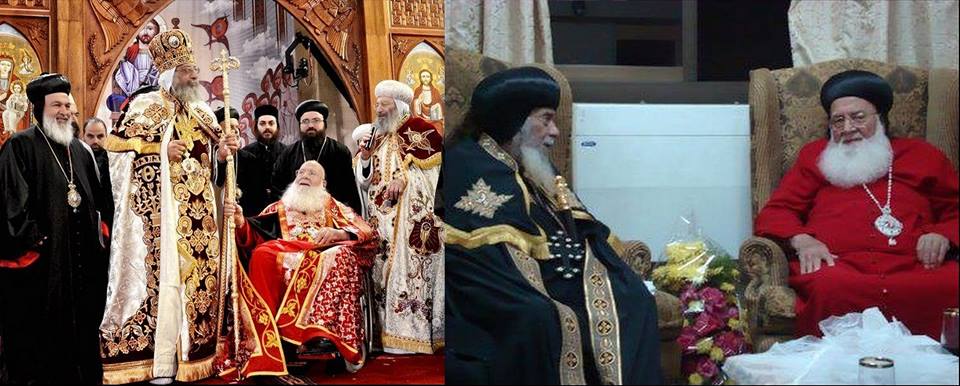
For myself and on behalf of the Holy Synod of the Coptic Orthodox Church and
the congregation in Egypt and abroad, we would like to extend our cordial
condolences to their reverend Graces the Archbishops and the blessed
congregation of the Syrian Orthodox Church for the reposal of His Holiness Moran
Mor Ignatius Zakka I Iwas, the Patriarch of the sister Syrian Orthodox Church.
We are expressing our consolations, however we are joyfully praying so that his
virtuous soul may rest in peace in the bosom of all the saints. He will always
be remembered for his ultimate care, efforts and love to render the church
unified.
May God help us select a good successor to keep up his track.''
|
||
|
|
||
|
by Rev. Dr Olav Fykse Tveit We thank God for the life and witness of Patriarch Ignatius Zakka Iwas; and, we offer our heartfelt condolences to his church and his beloved spiritual sons and daughters. May his memory remain eternal in our Lord’s mind and in the hearts of all who knew and loved him. Rev. Dr Olav Fykse Tveit WCC General Secretary |
||
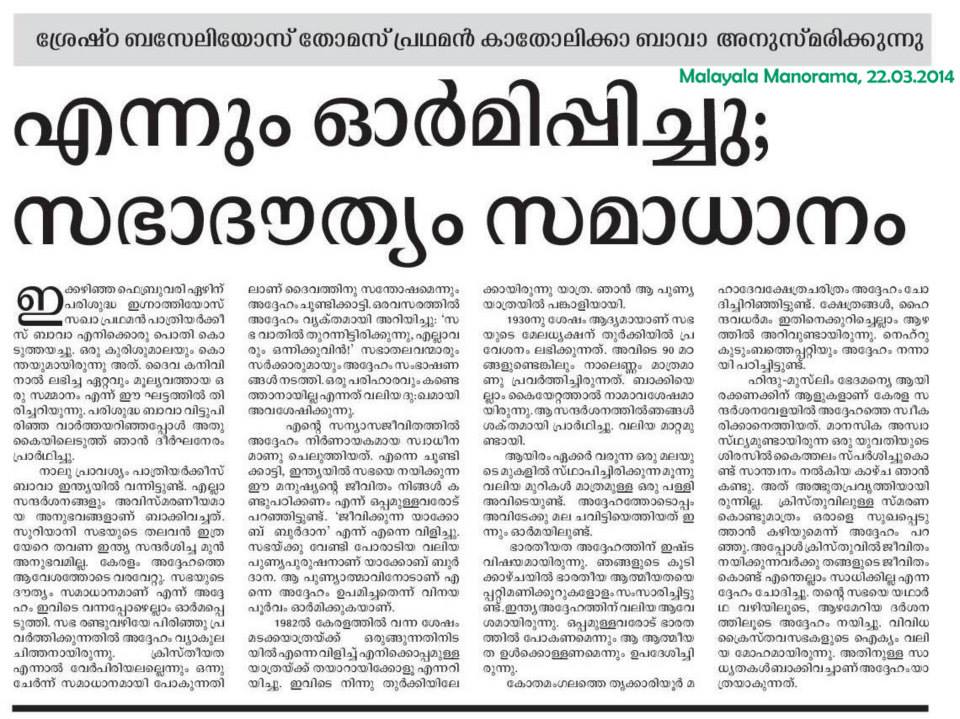 Source: Malayala Manorama
Source: Malayala Manorama
|
||
 Source: Deepika, Mar 22, 2014
Source: Deepika, Mar 22, 2014
|
||
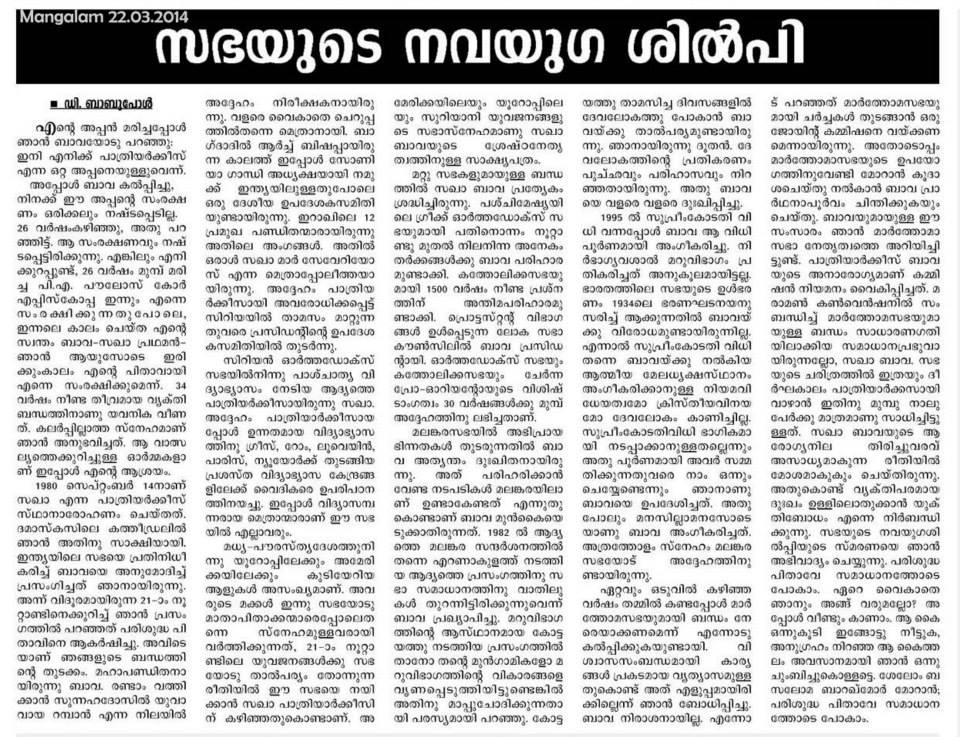
Source: Mangalam, Mar 22, 2014
|
||
|
FUNERAL PHOTO GALLERY |
||
|
This is a collection of photographs to recall the funeral
services of LL HH Zakka I Iwas, the Patriarch of Antioch. Please click here to take you to the photo album. Here is what you will find in our collection: 28. FAREWELL AND MEMORIAL SERVICE IN GERMANY 29. FAREWELL AND FUNERAL SERVICE IN LEBANON 30. FAREWELL AND FUNERAL SERVICE IN DAMASCUS, SYRIA - THE FINAL DESTINATION |
||
|
With over 6000 articles and hundreds of
links to outside resources covering all aspects
of Syriac Orthodoxy that are of interest to Family, Malankara World is the
premier source for information for Malankara Diaspora. In addition to articles on
spirituality, faith, sacraments, sermons, devotionals, etc., Malankara World also
has many general interest articles, health tips, Food and Cooking, Virtual Travel,
and Family Specific articles. Please visit
Malankara World by clicking here or cut and paste the link on your browser:
http://www.MalankaraWorld.com/Library/default.htm
Malankara World Journal Subscription If you are not receiving Malankara World Journal directly, you may sign up to receive it via email free of cost. Please click here: http://www.MalankaraWorld.com/Library/Register/news_regn.asp You can contact us via email at mail@malankaraworld.com Malankara World Journal Archives Previous Issues of Malankara World Journal can be read from the archives here. You can contact us via email at mail@malankaraworld.com Thank you for your help and support. Malankara World Team |
||
|
Malankara World Journal is published by MalankaraWorld.com
http://www.MalankaraWorld.com/
Copyright © 2011-2019 Malankara World. All Rights Reserved. |
